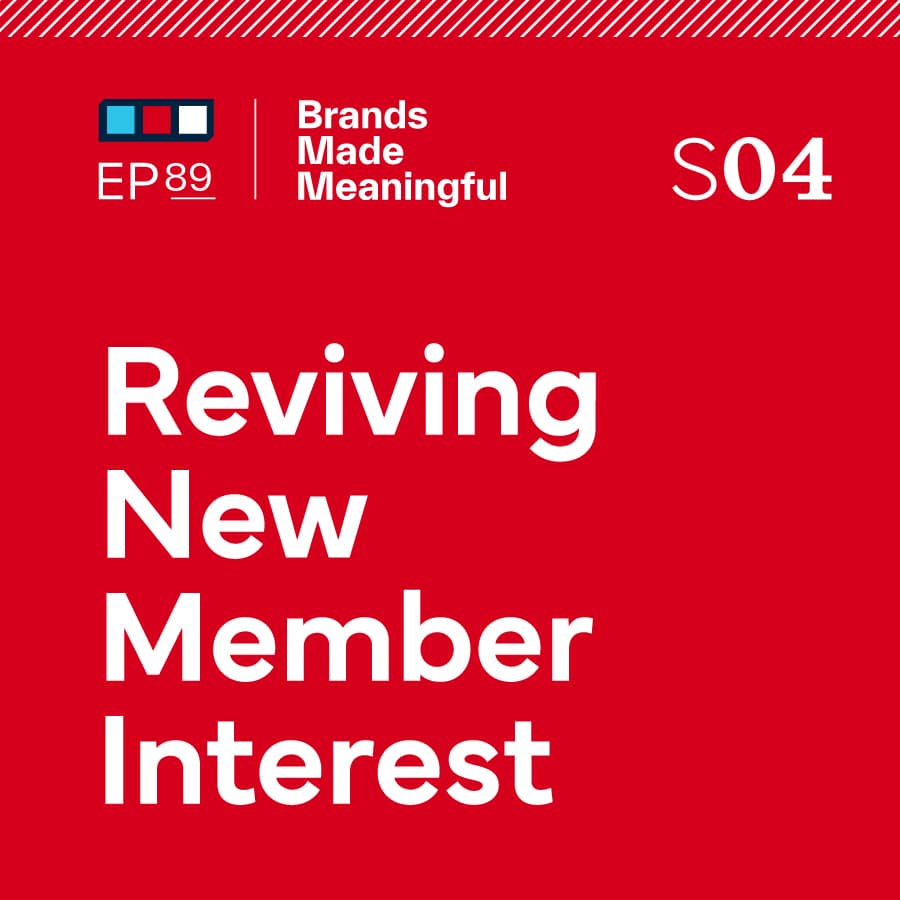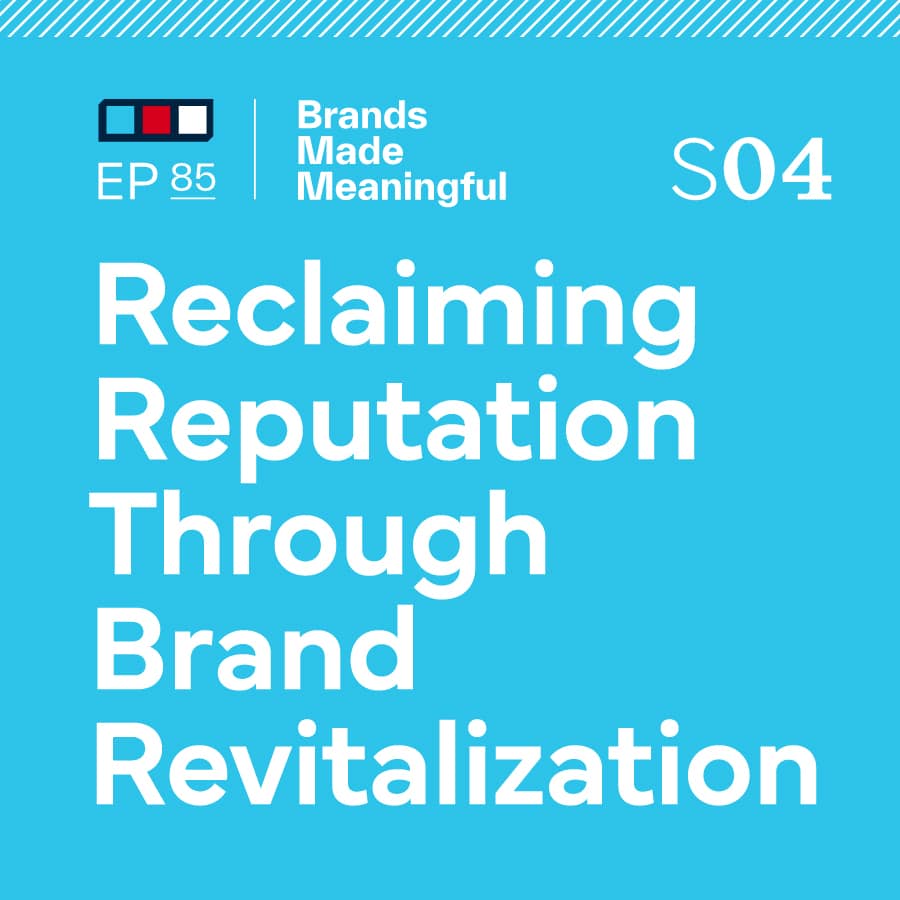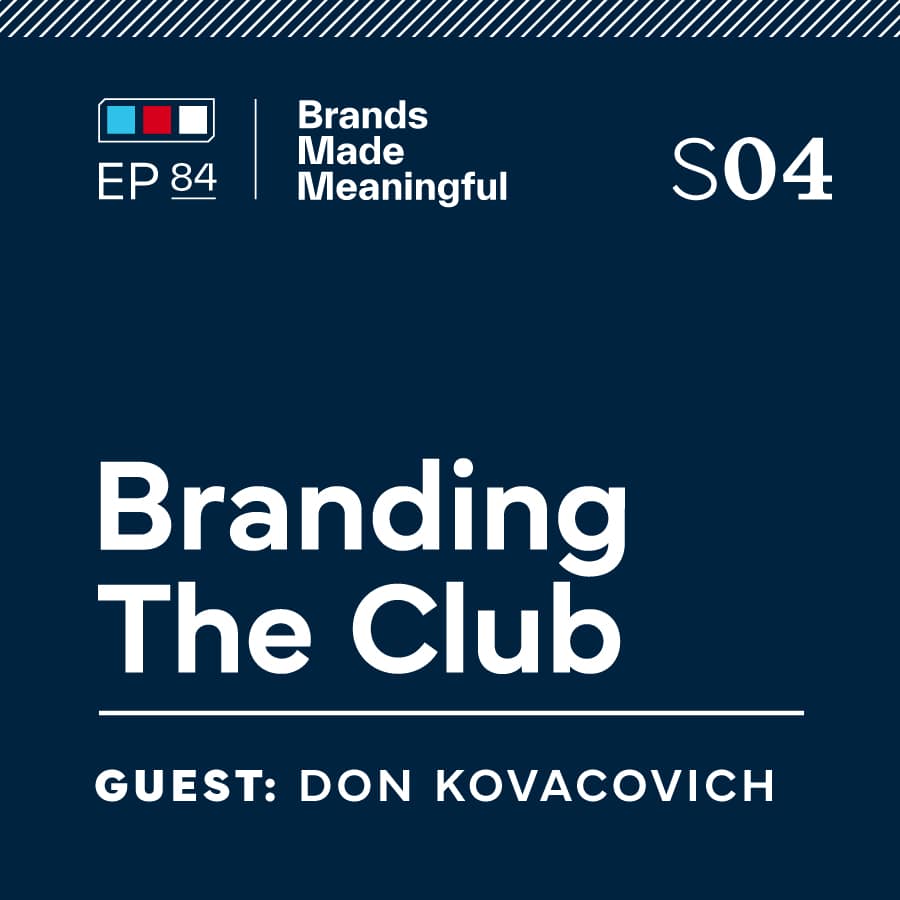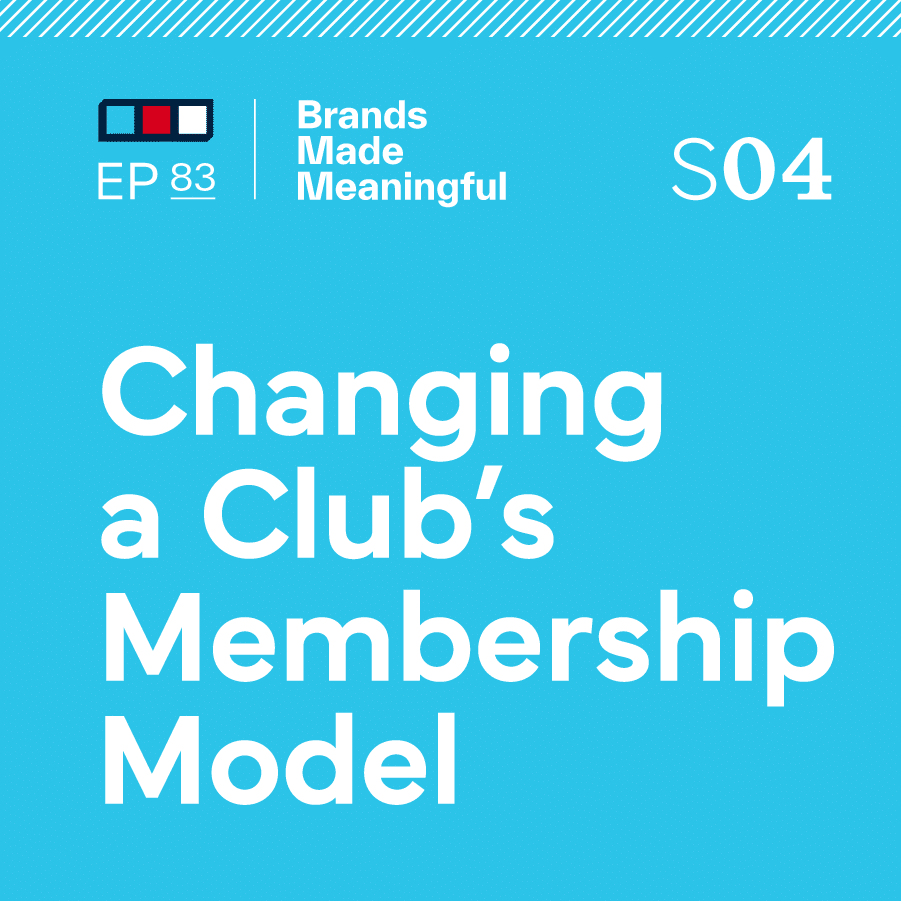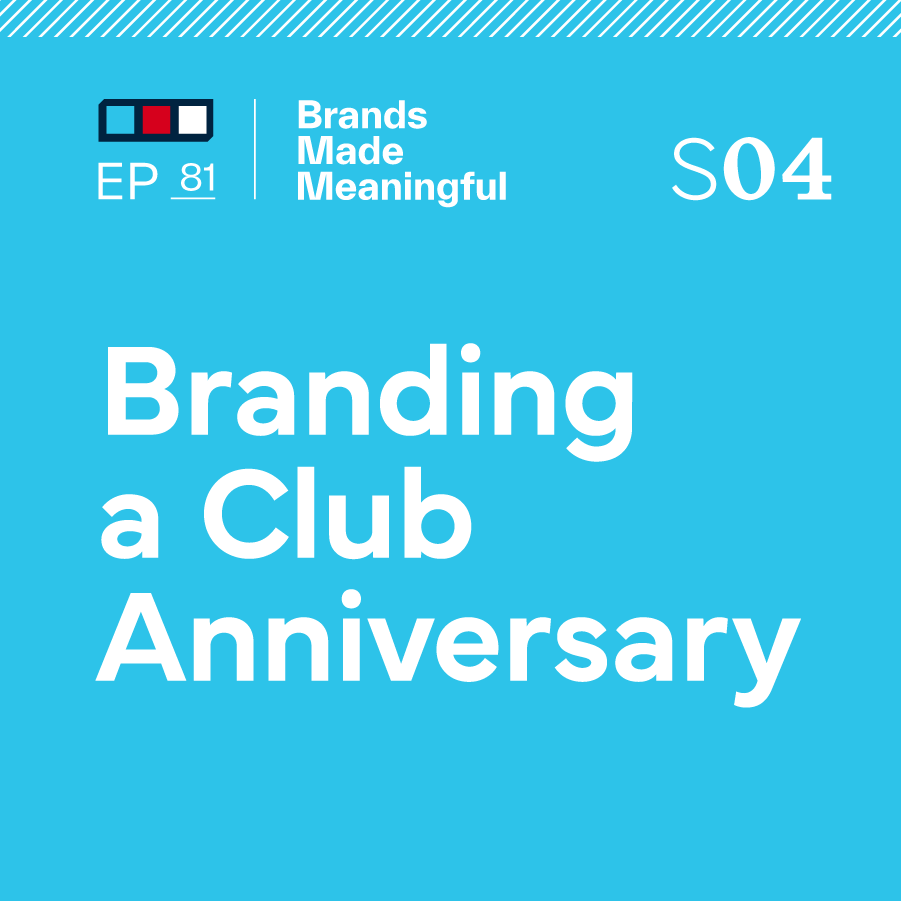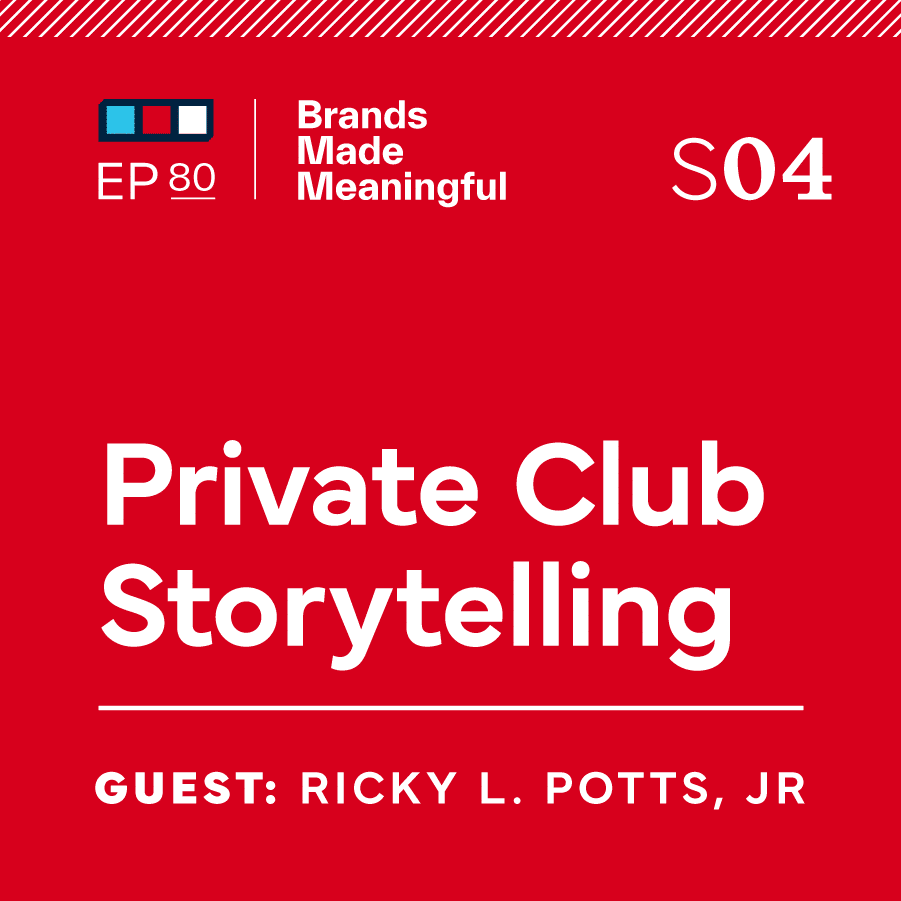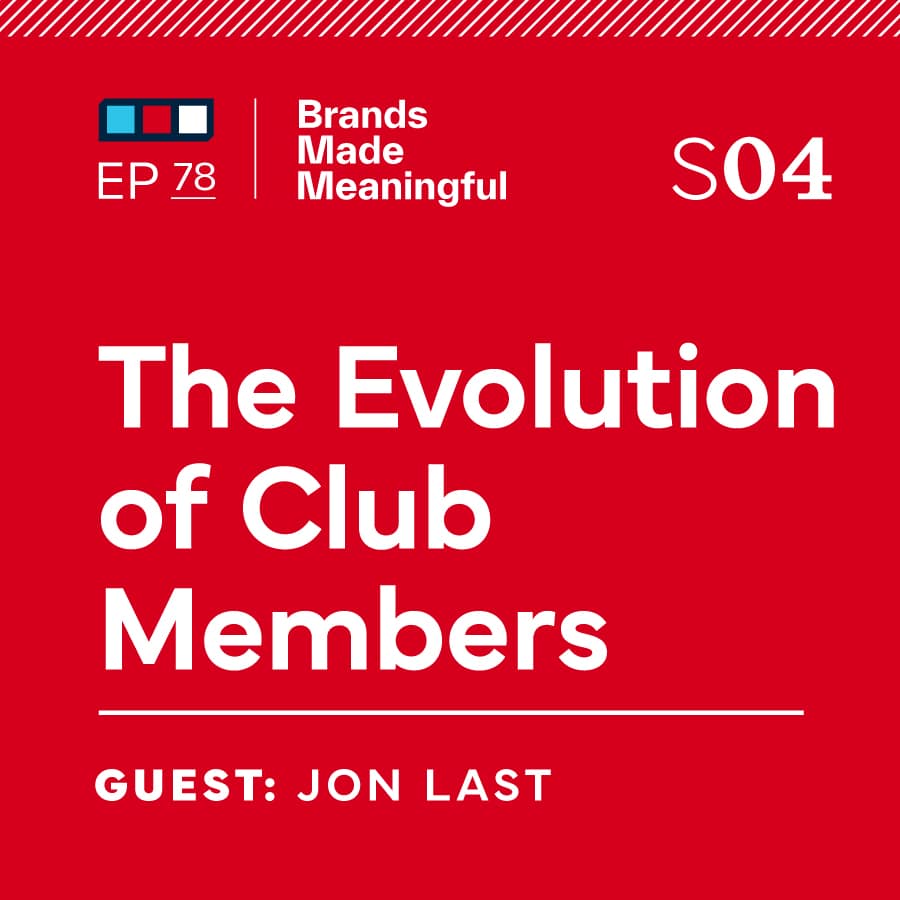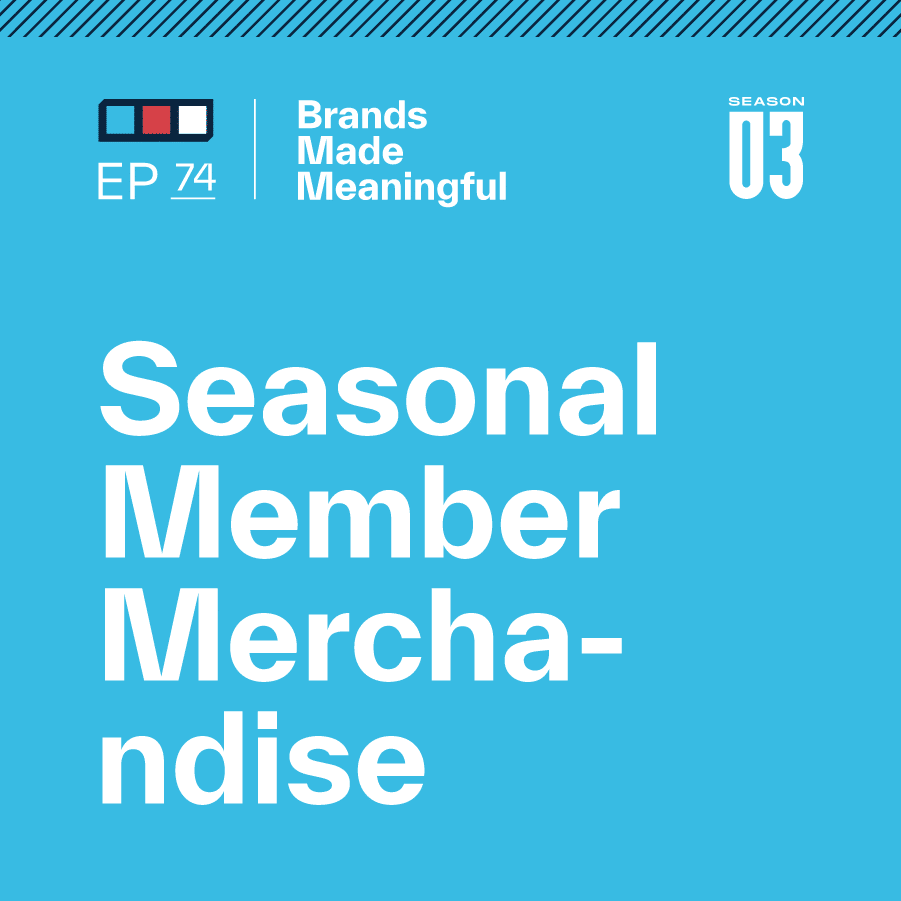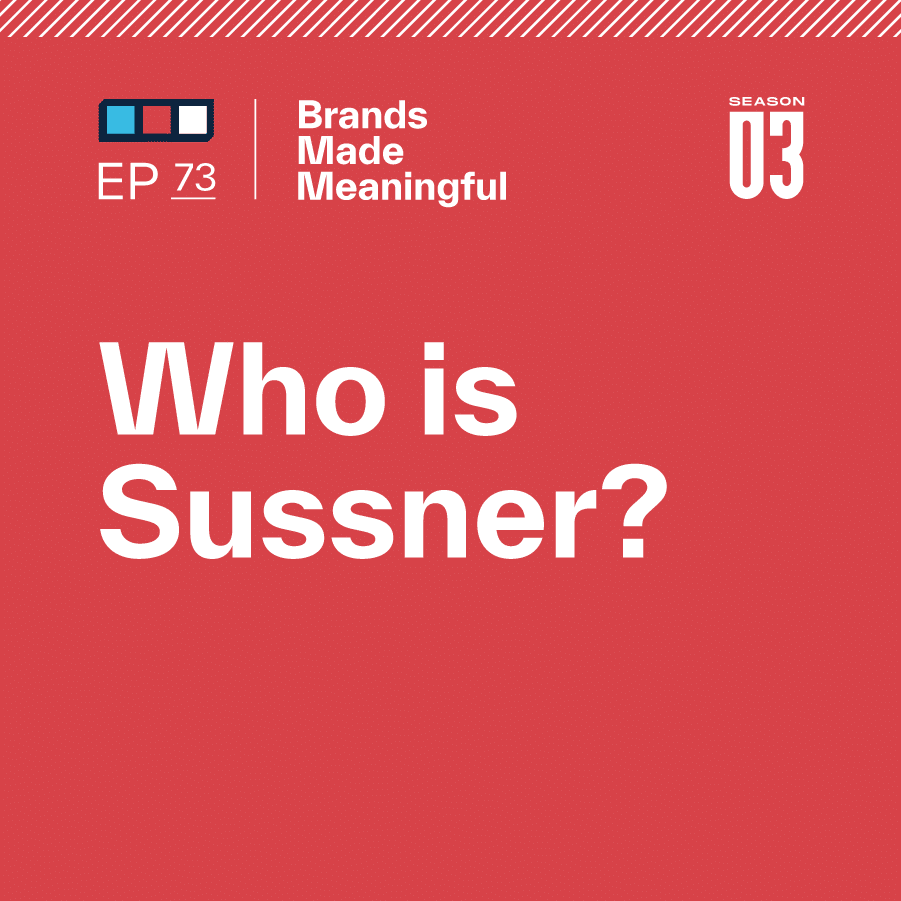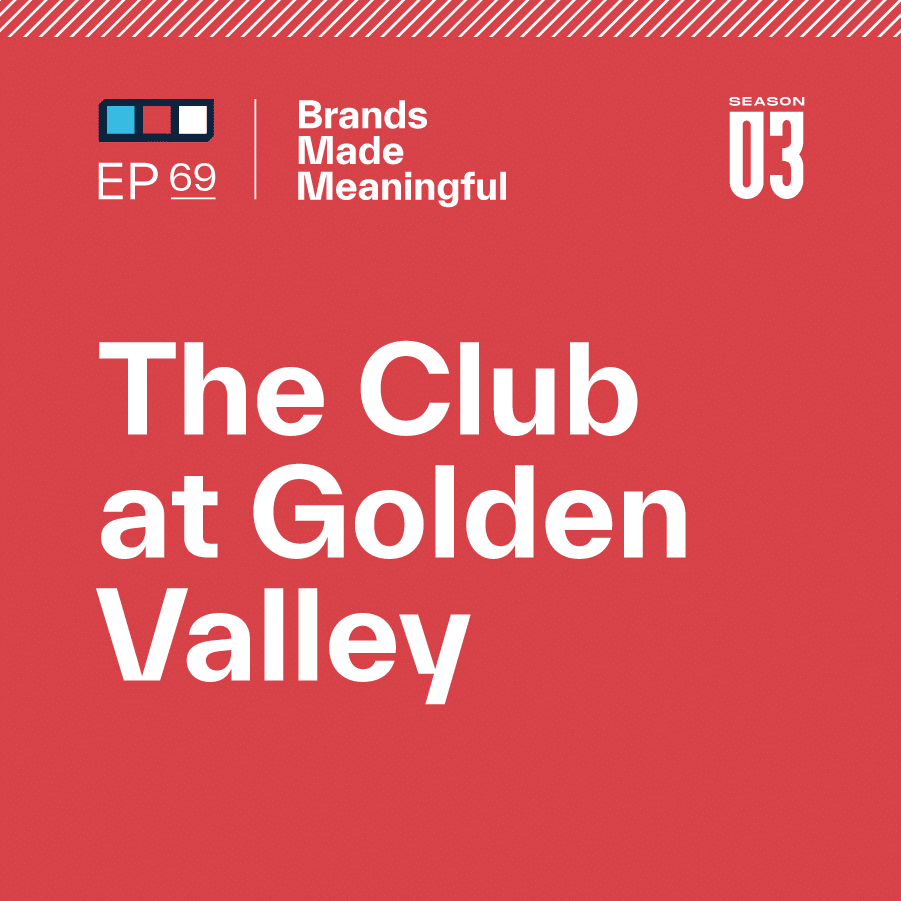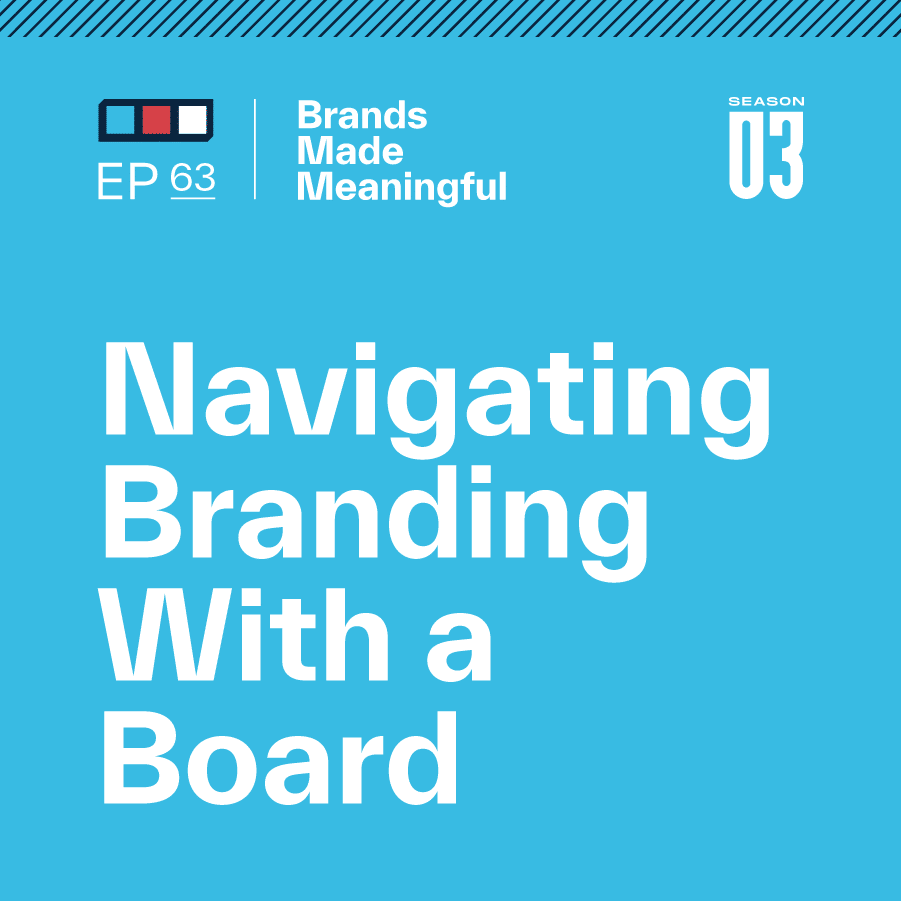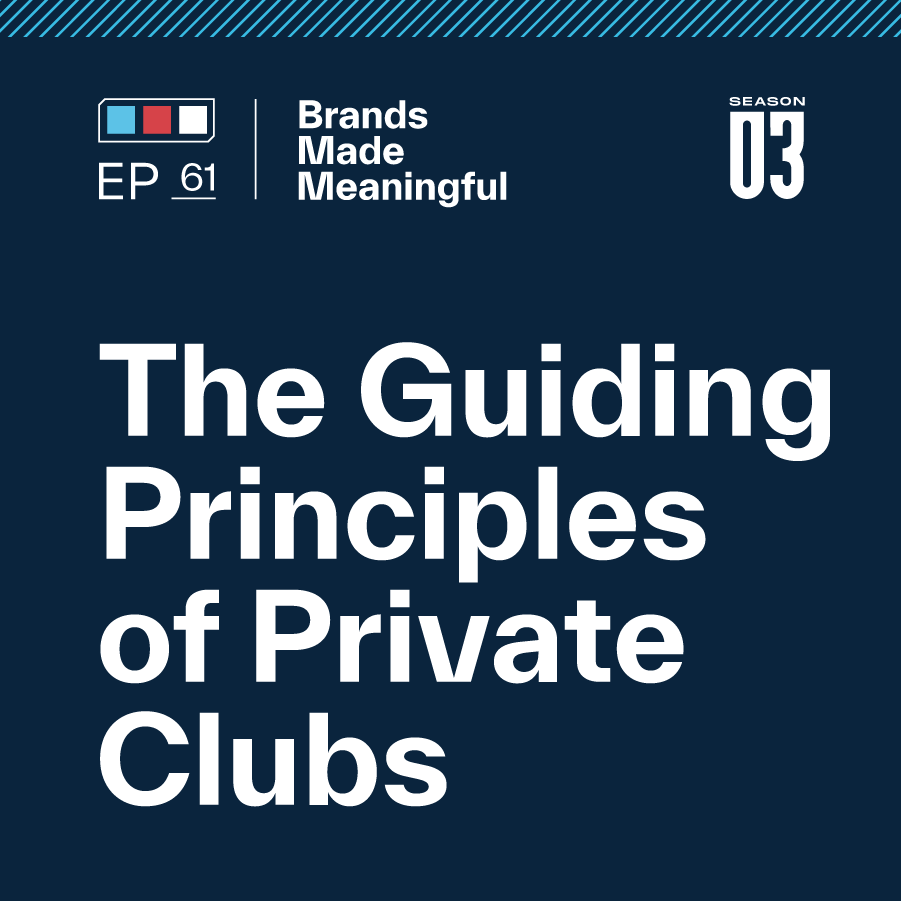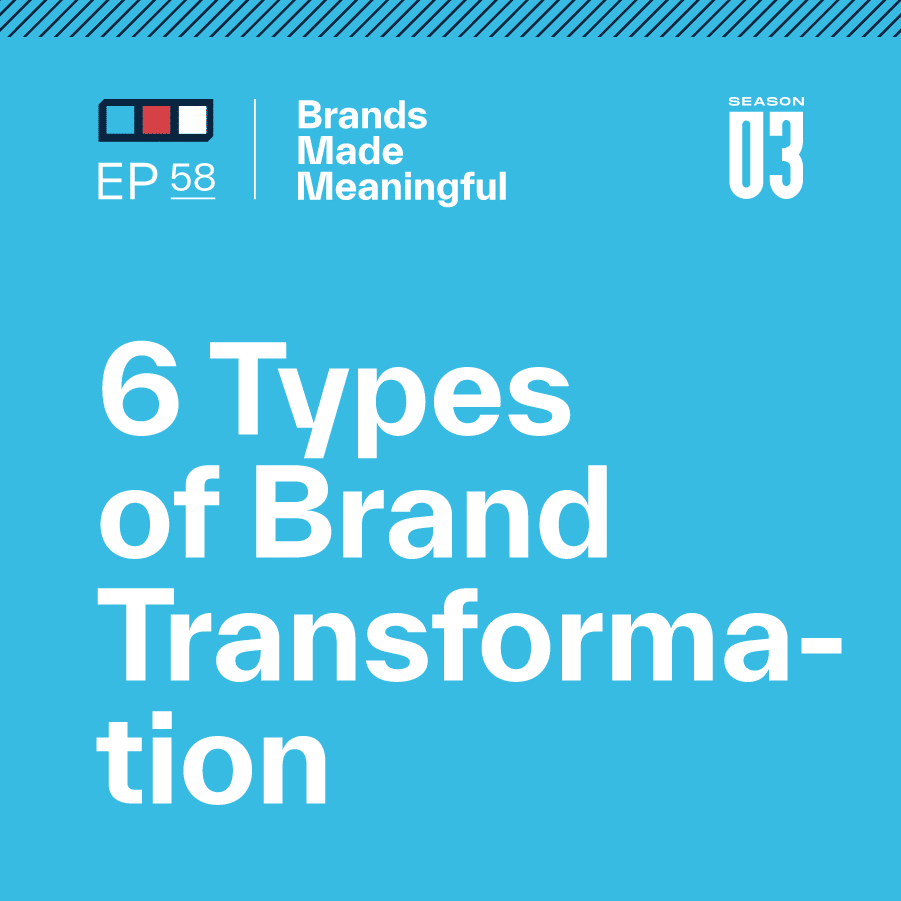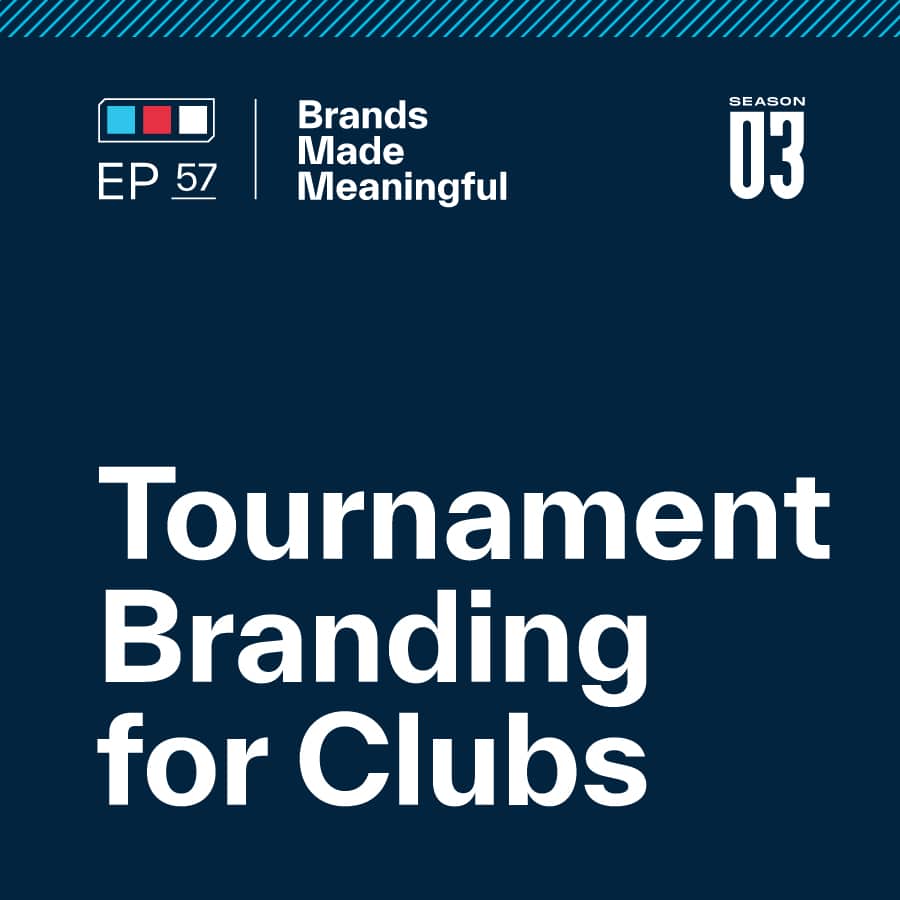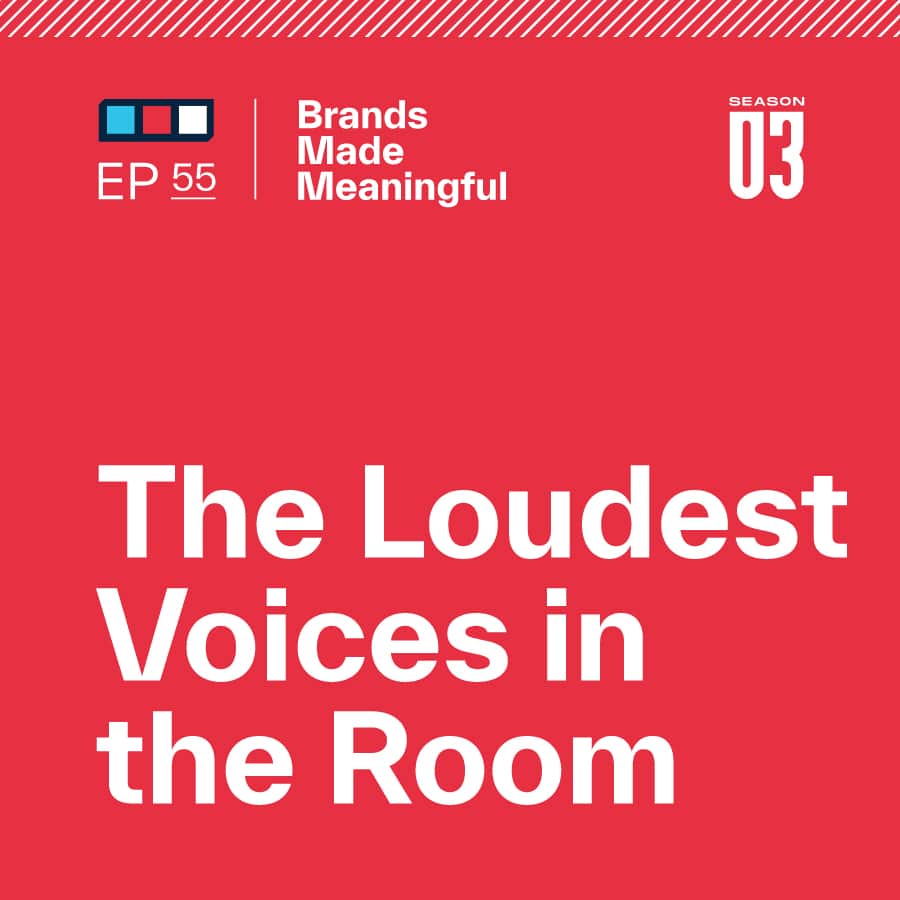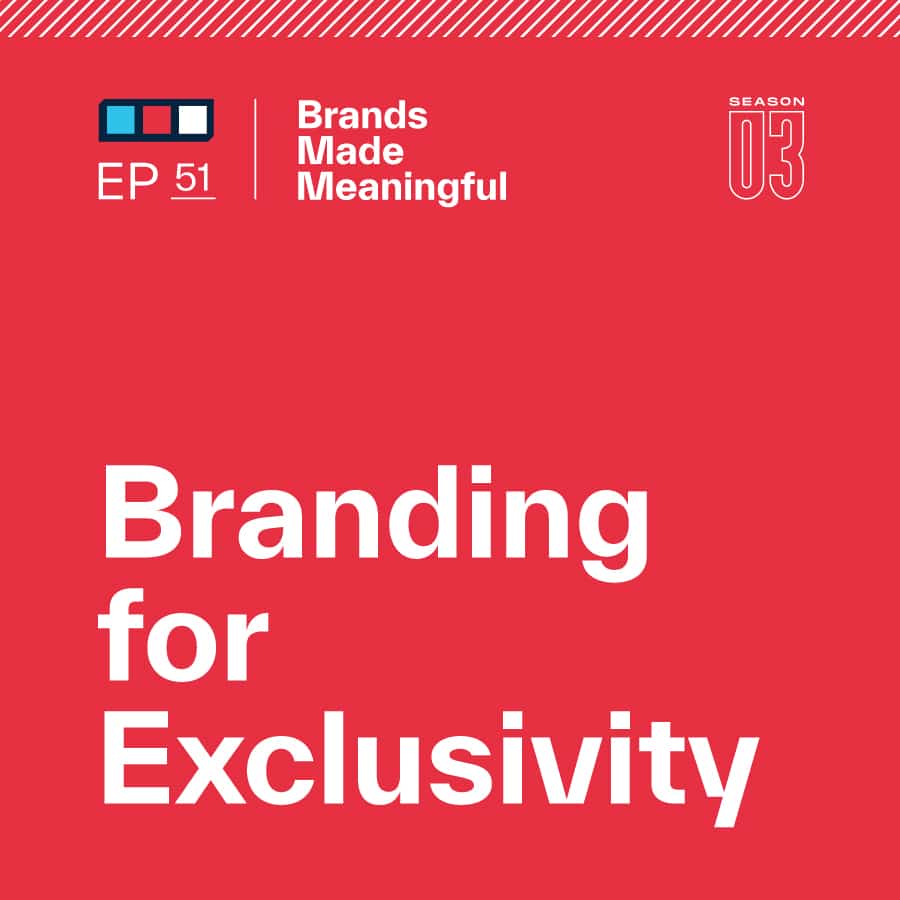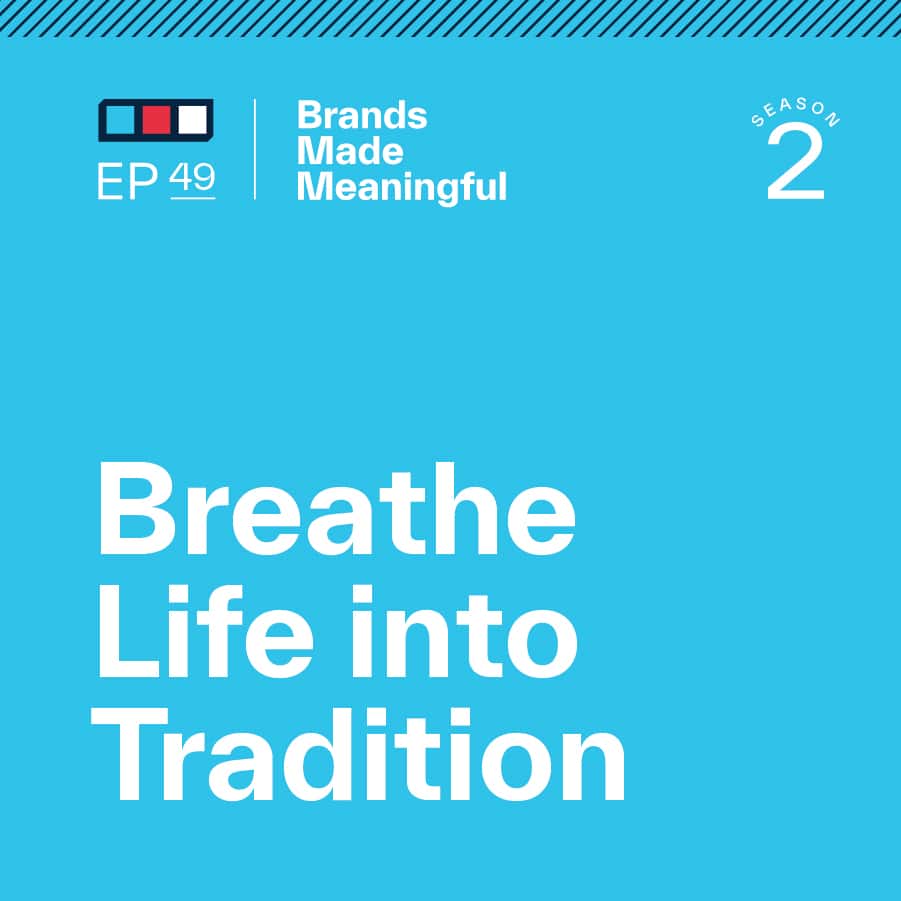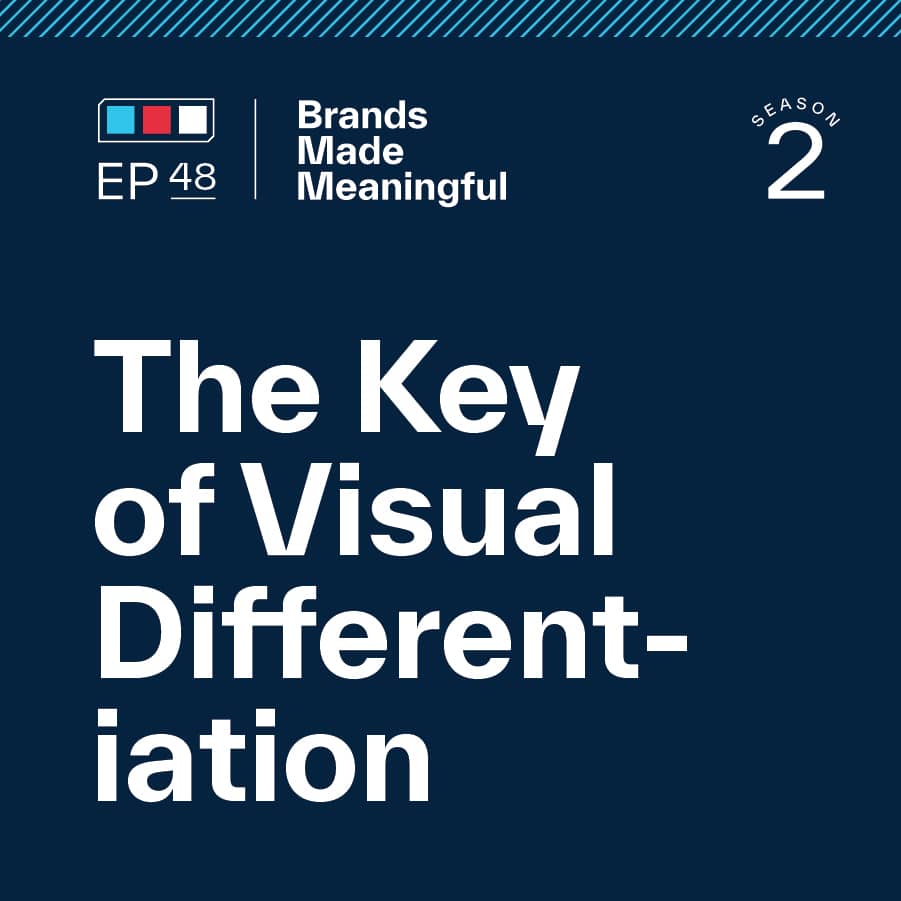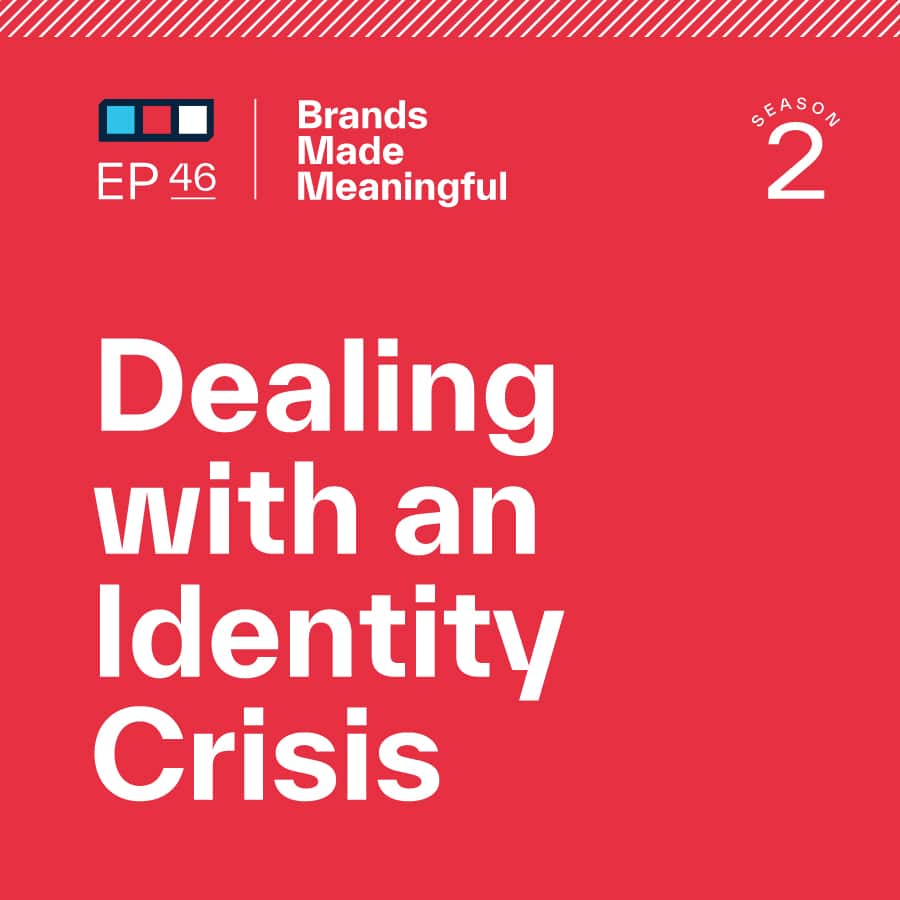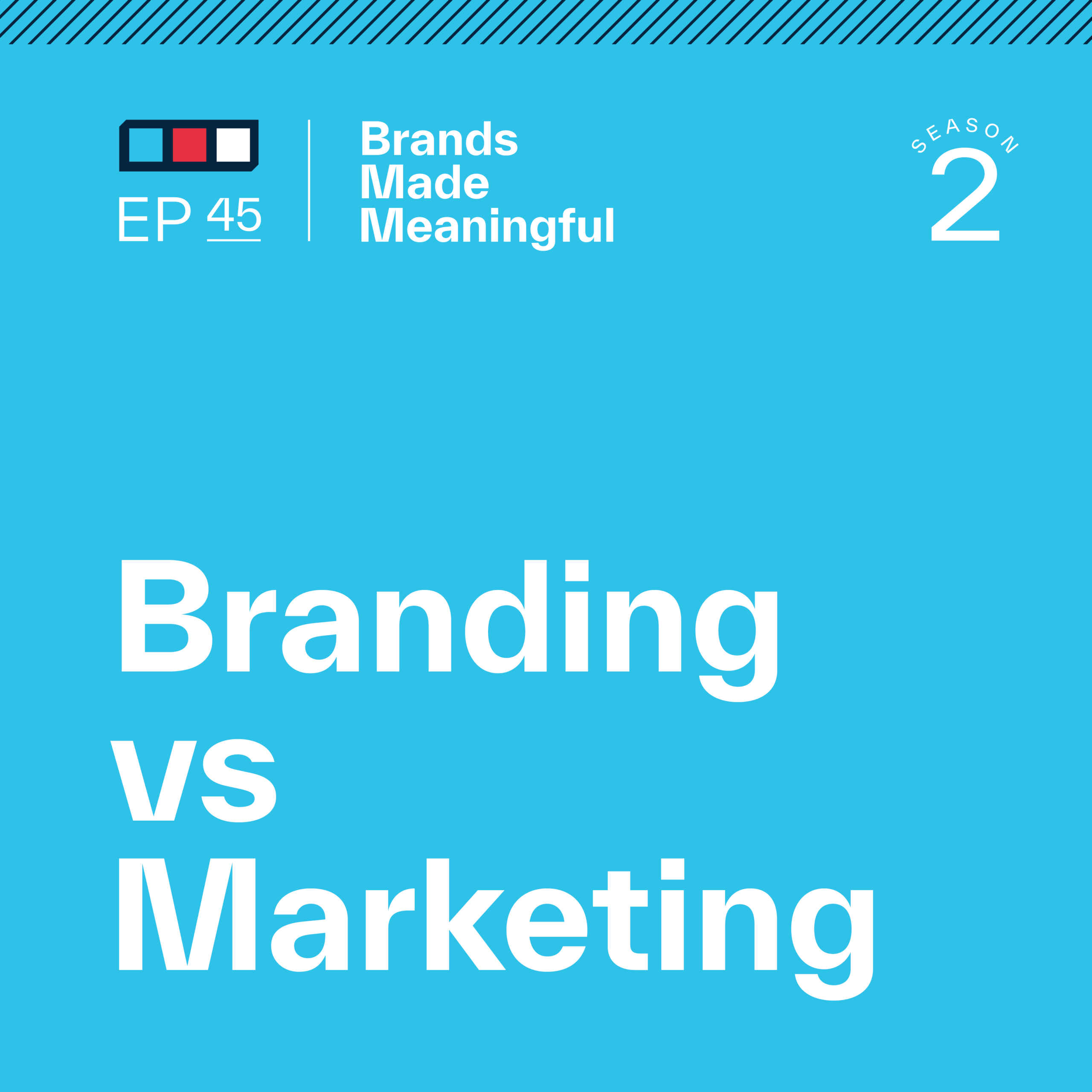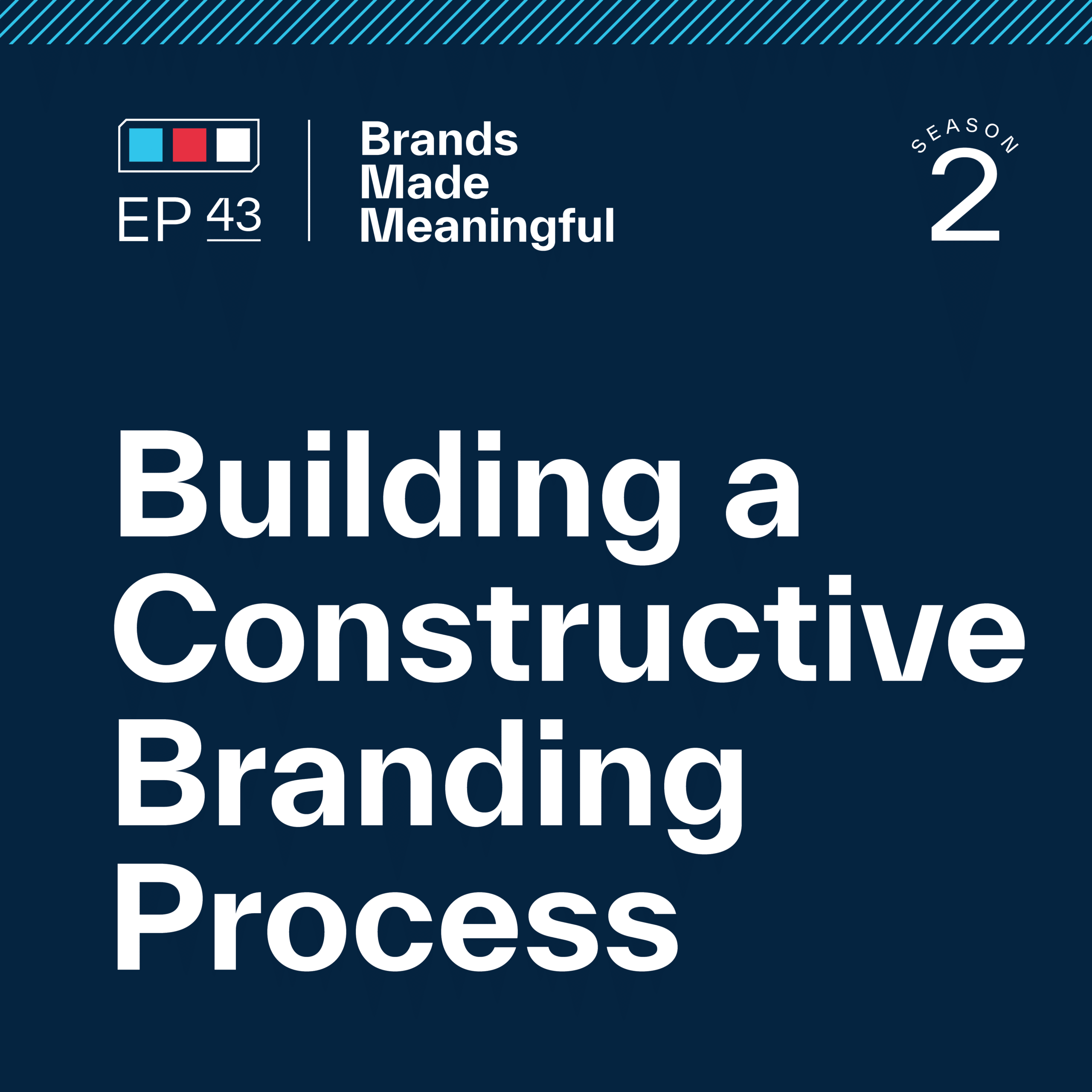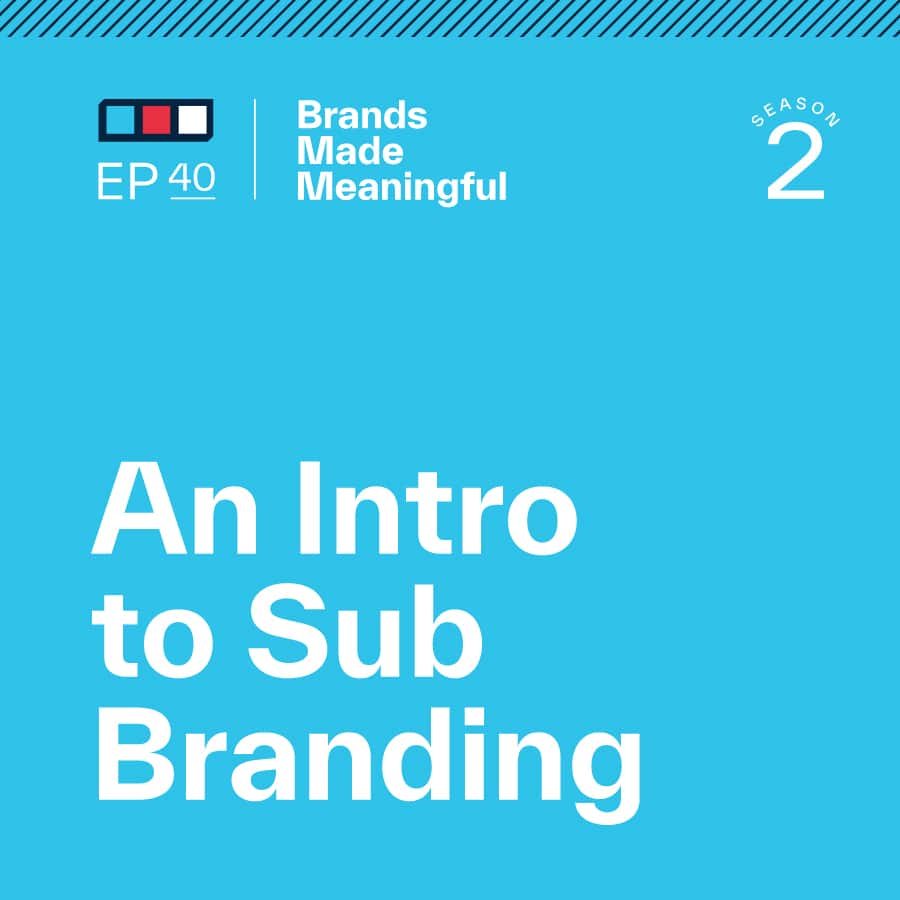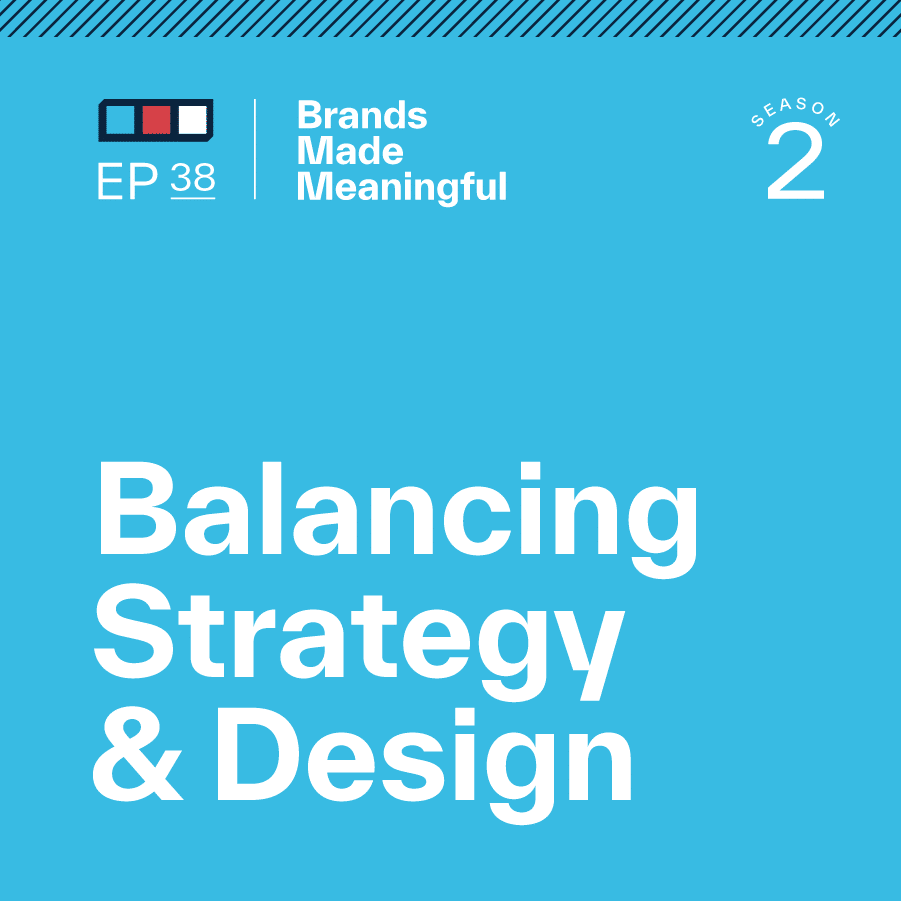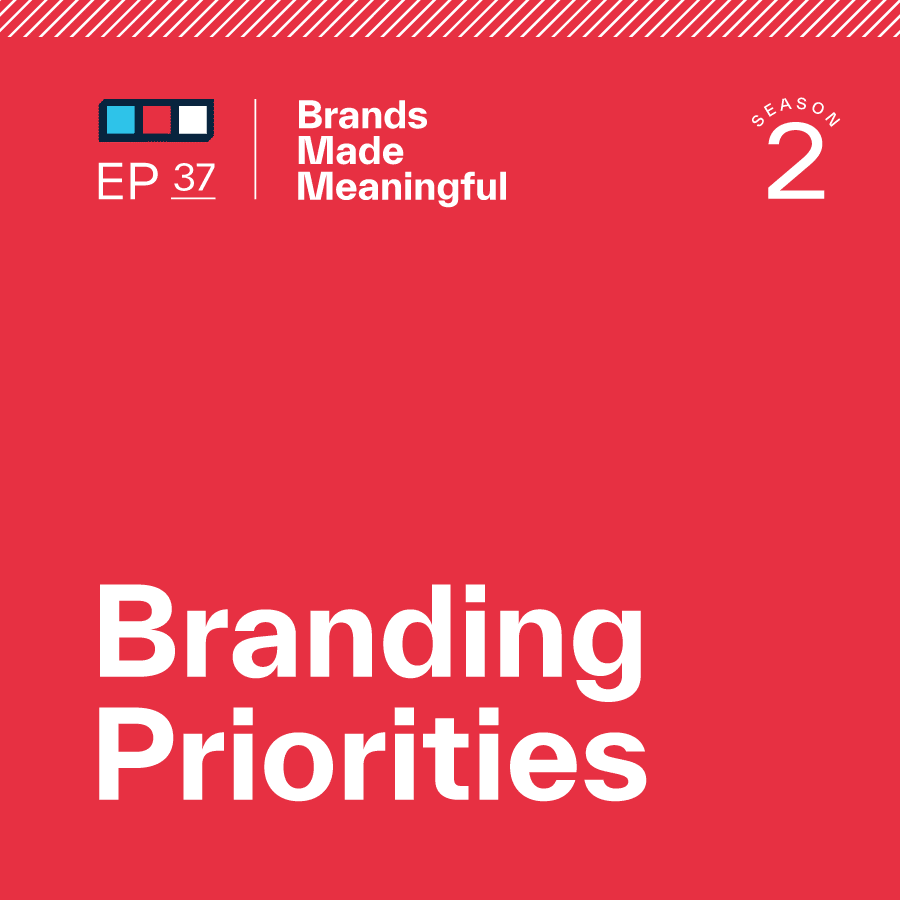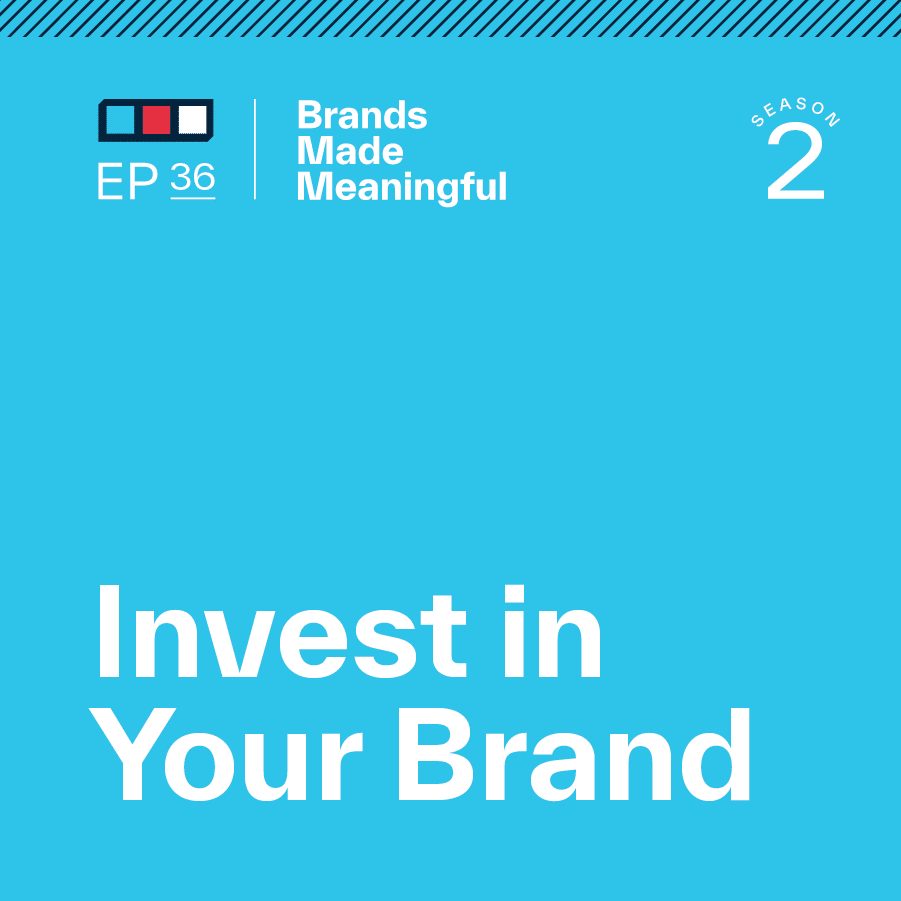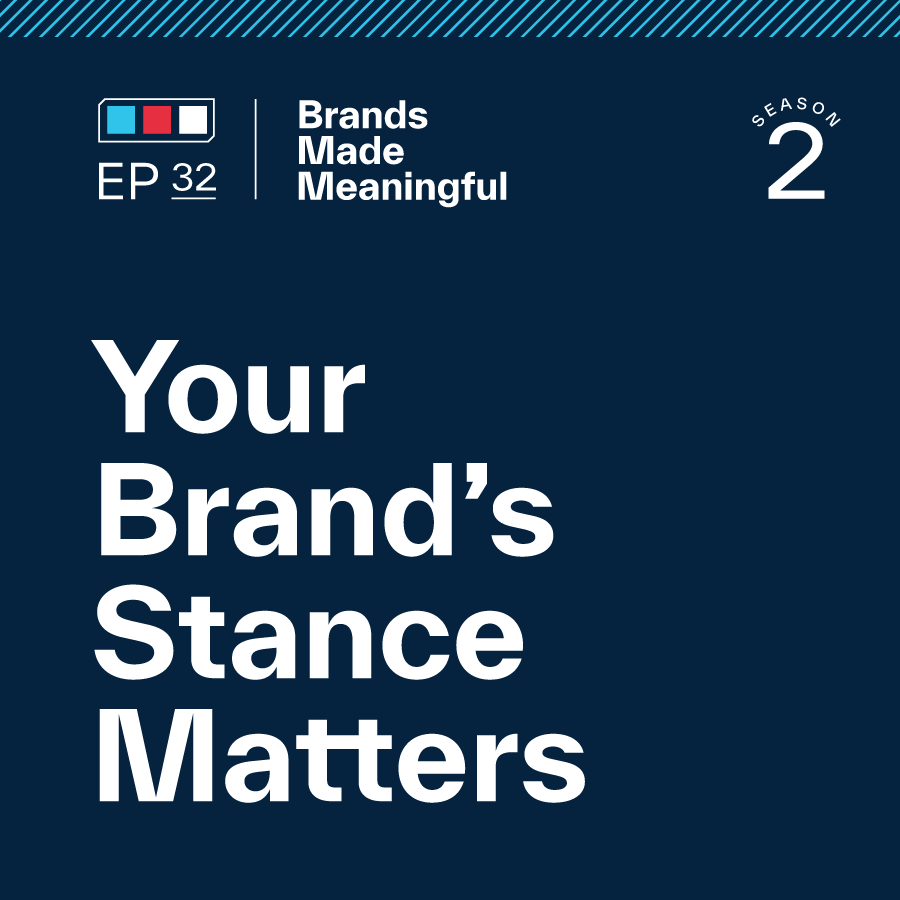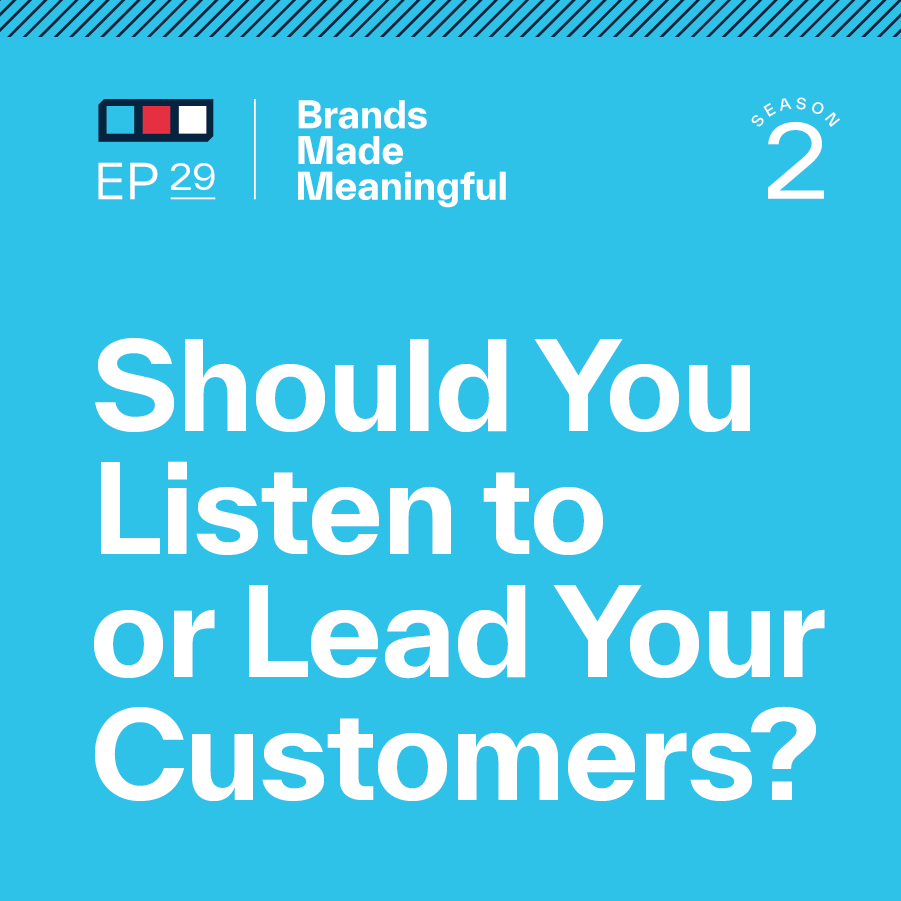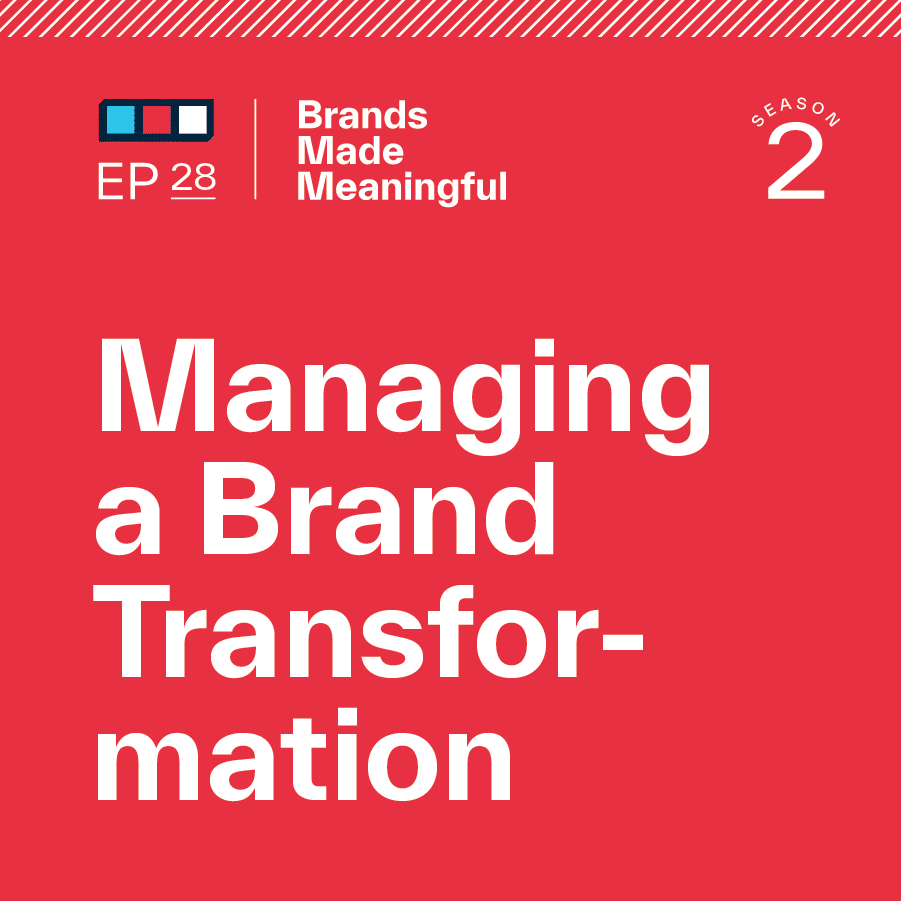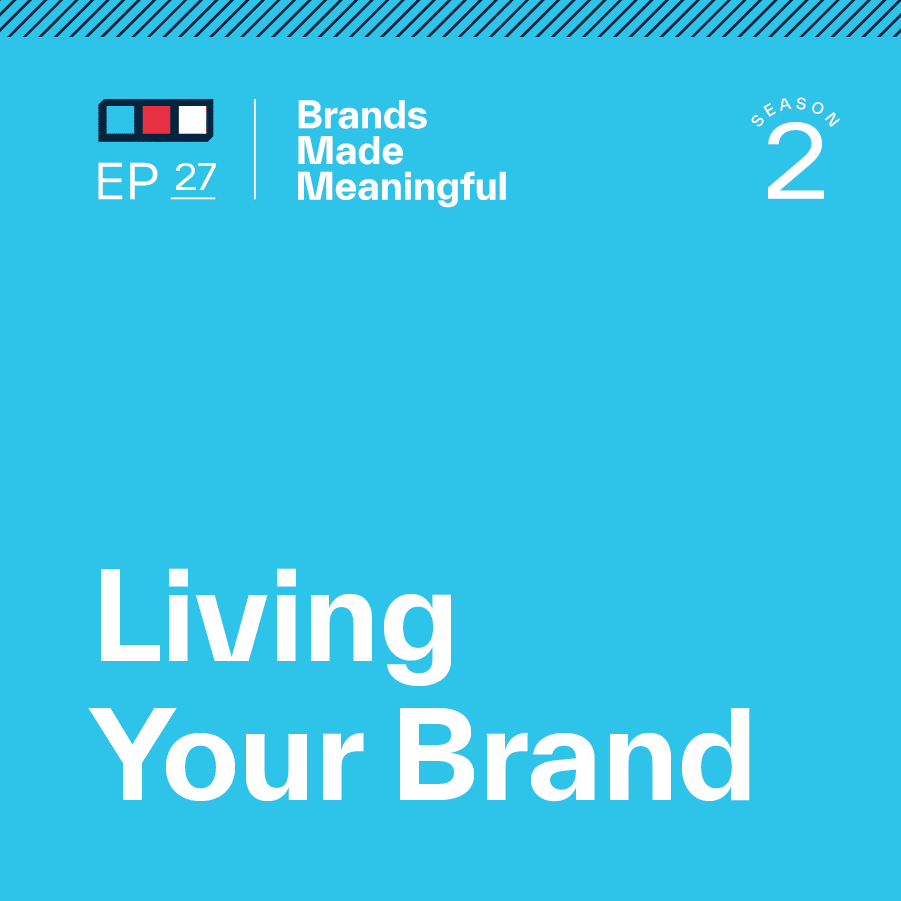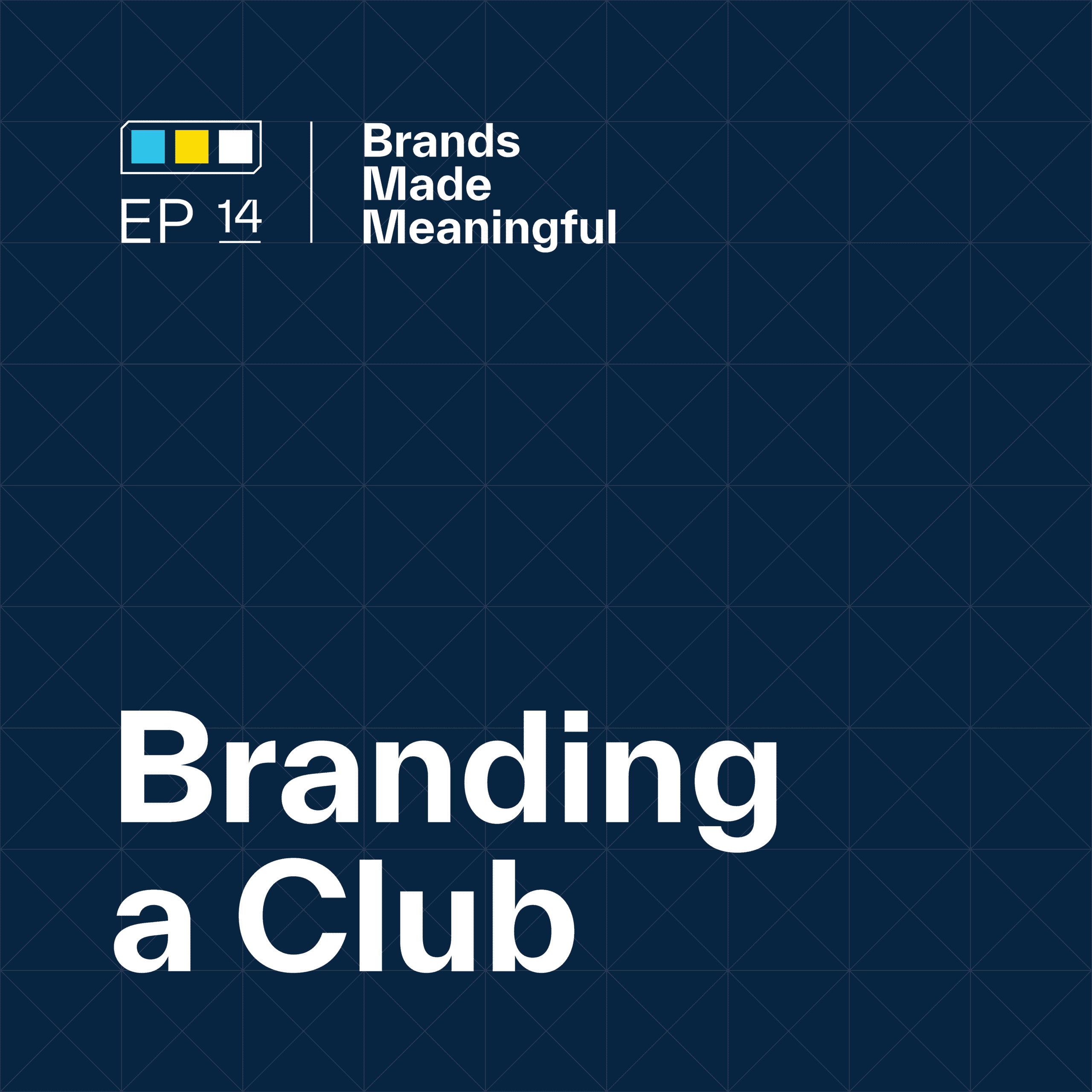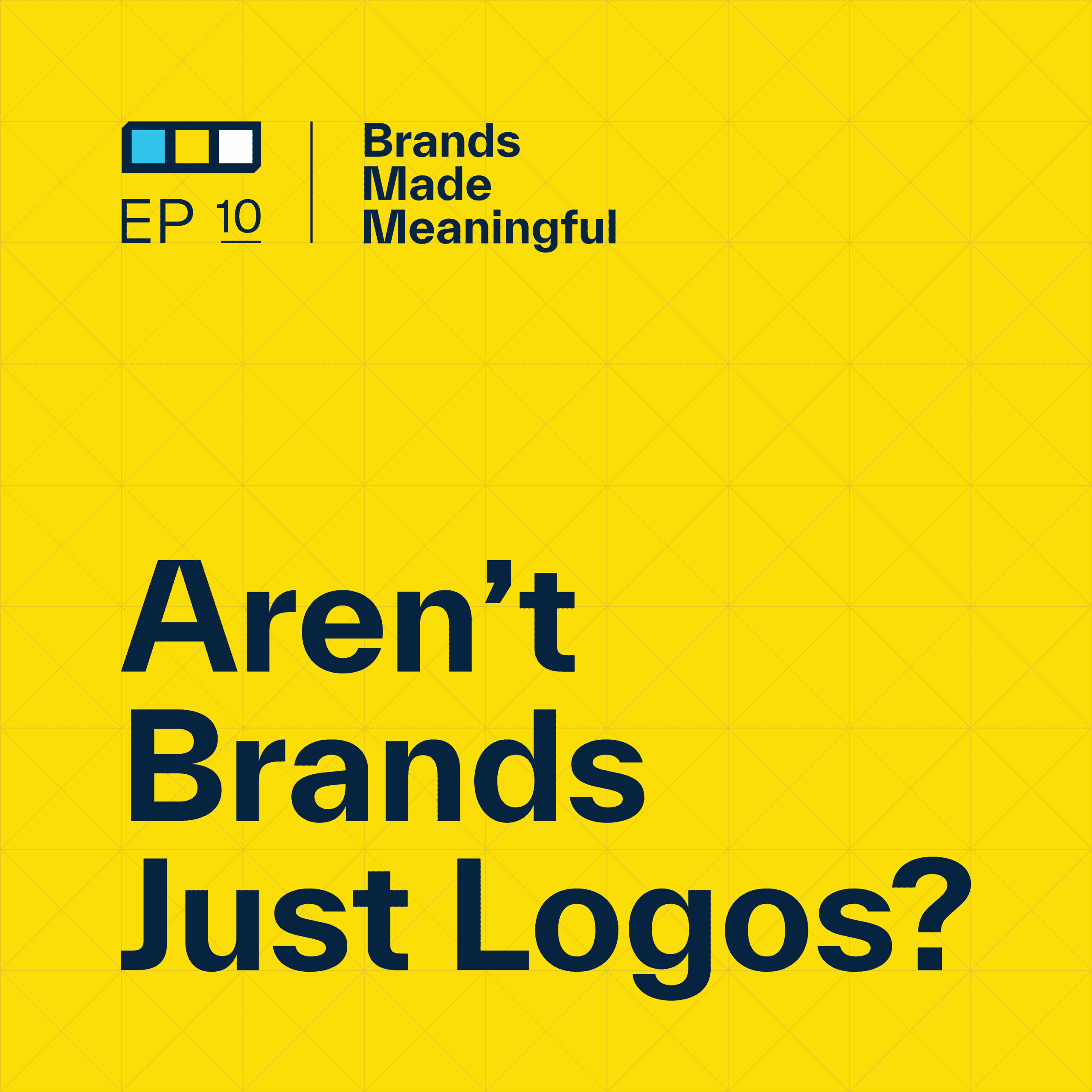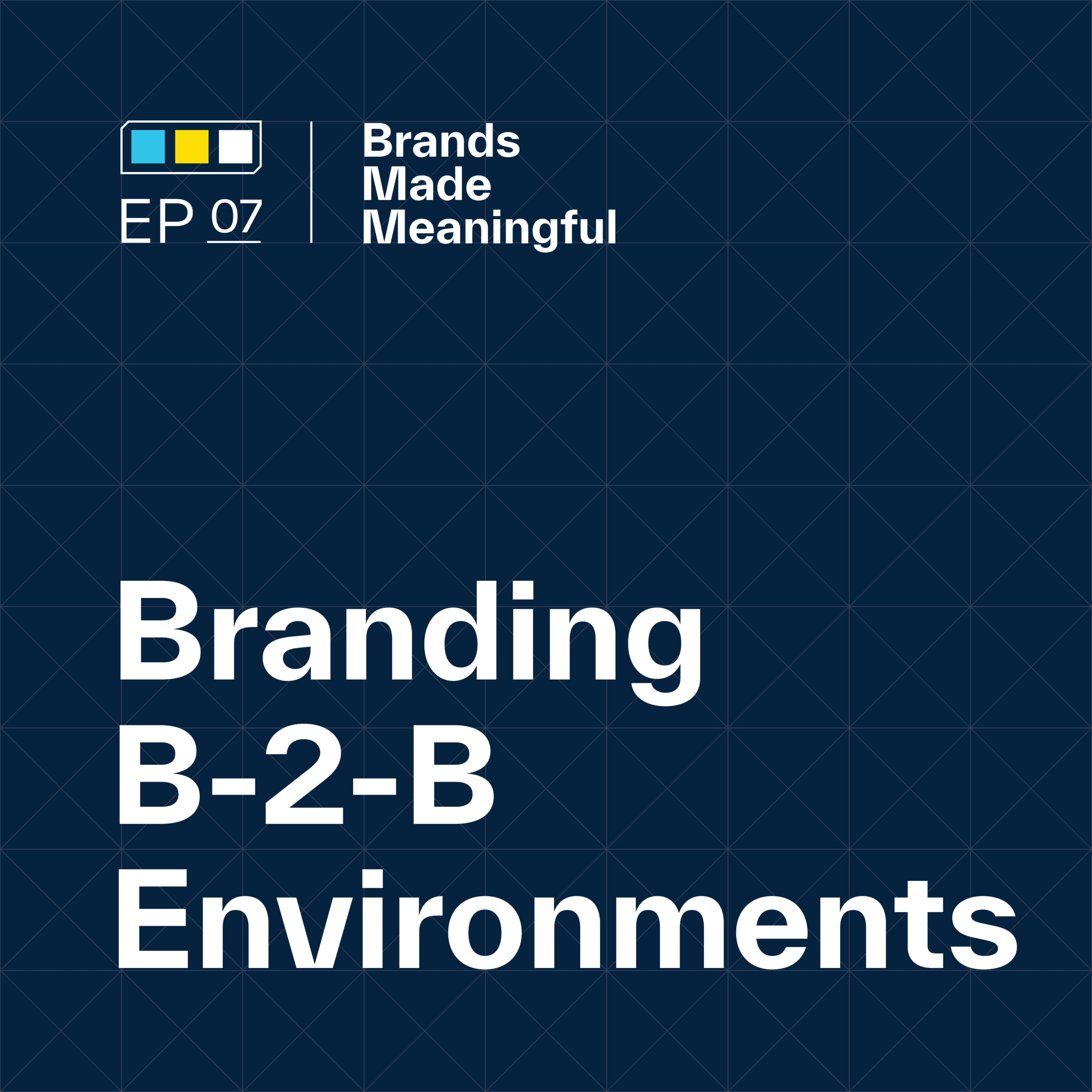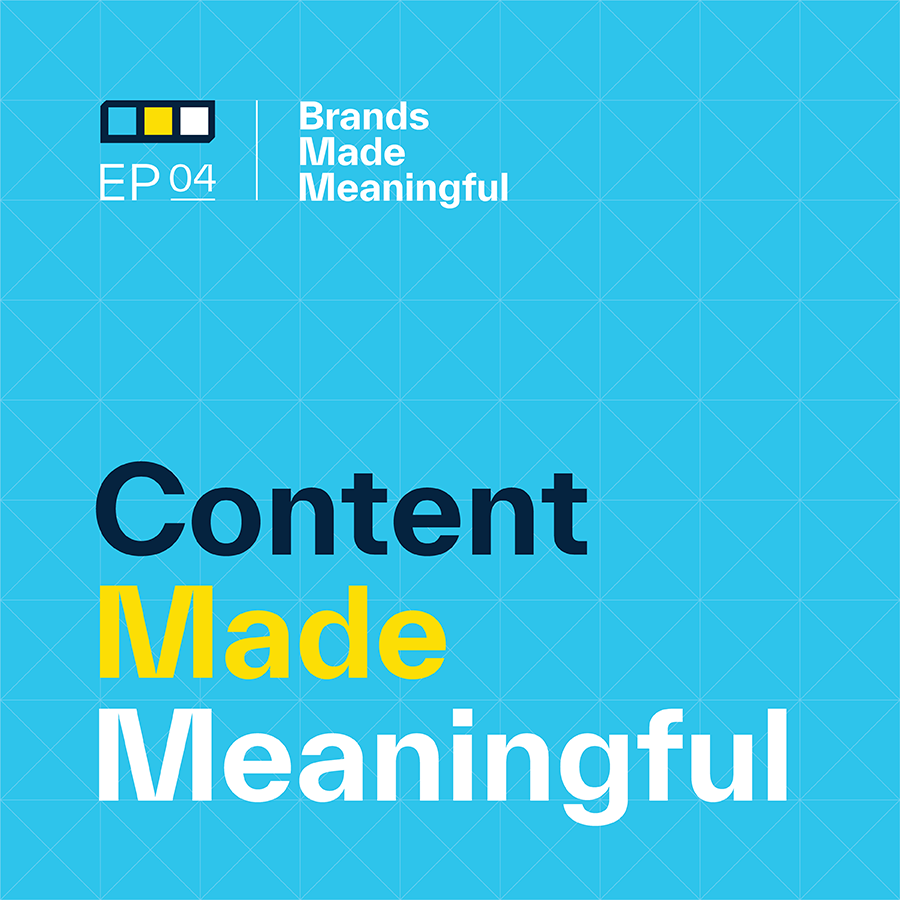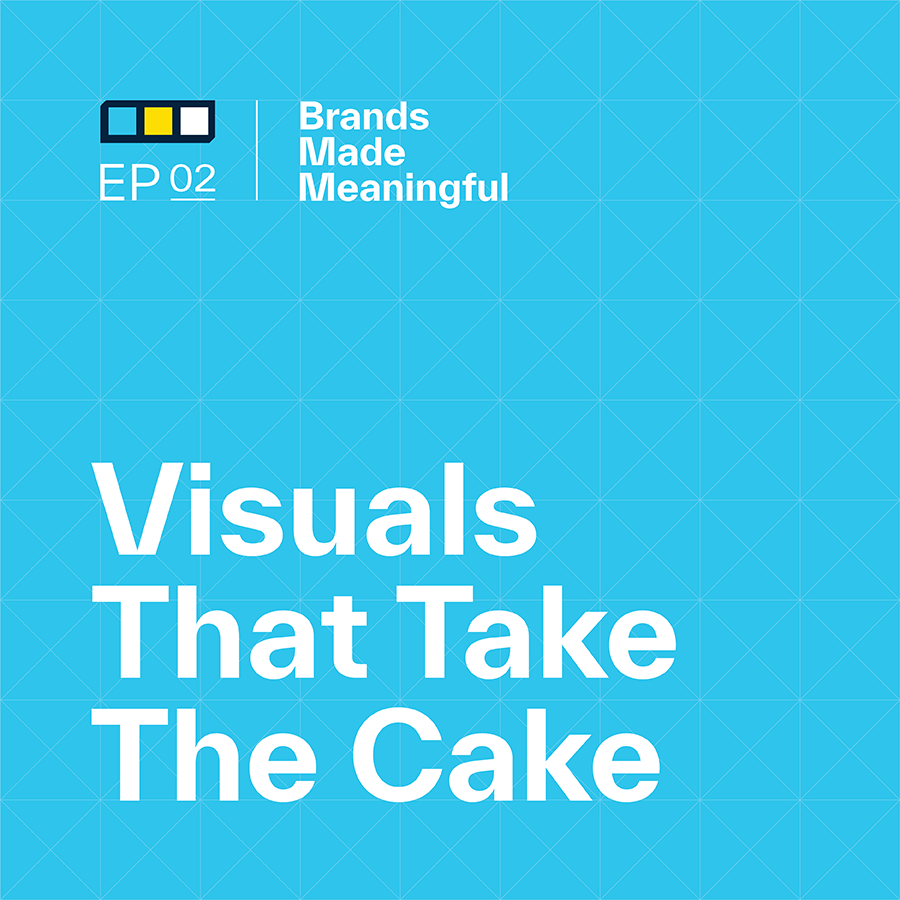EPISODE 64
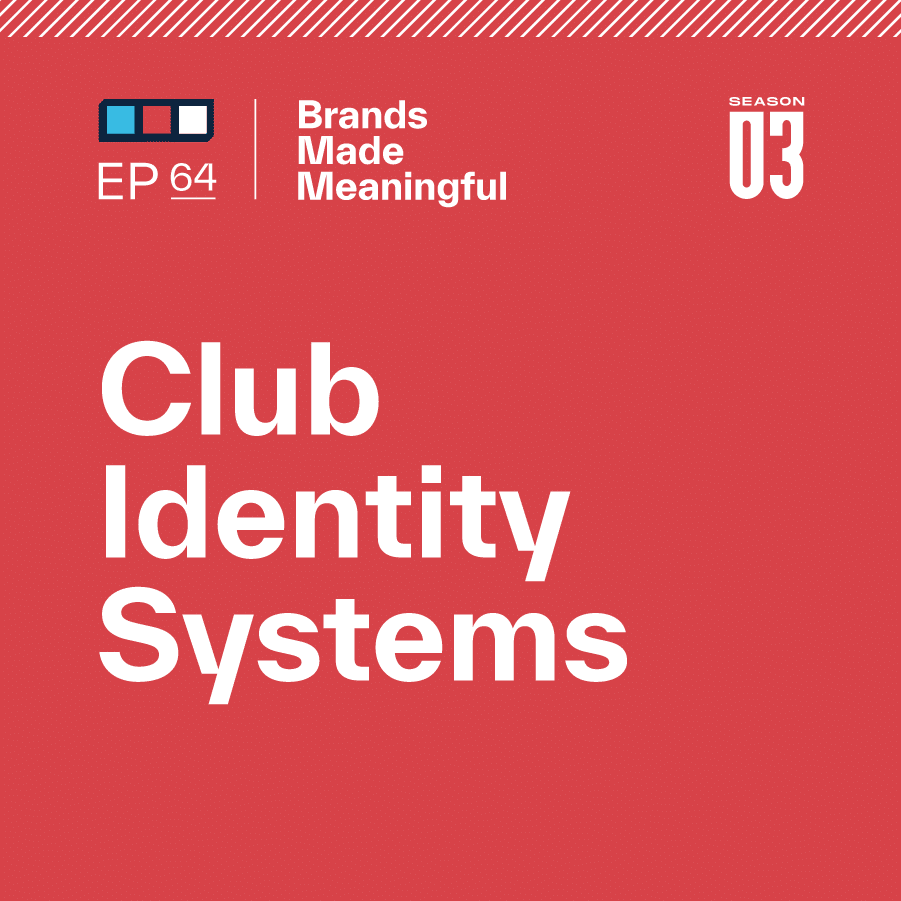
Club Identity Systems
Episode 64
Derek and Tucker cover what Identity Systems entail and how to discern between internal and external methodologies.
EPISODE TRANSCRIPTION
This conversation is going to be an interesting one. So for any of you watching, you’re going to see actual work that we’ve done.
Tucker Today we’re talking about identity systems. We’re working with a client right now who is getting to the point of moving into this identity system development. What we really want to talk about is: What is it? How does it work? How do we build it? And how do you know when you should be looking at redoing or editing your identity system?
Expand Full Transcript
Derek Welcome to Brands Made Meaningful conversations with the team at Sussner about how purposeful branding inspires unity, identity, and powerful change for growth-minded organizations. Tucker, we’re working in a new format today, for our 64th podcast episode.
Tucker Definitely old dogs, new tricks kind of a thing going on now. But this conversation is going to be an interesting one. So for any of you watching, you’re going to see actual work that we’ve done. We’re going to try this way of showing some work, which is exciting. But this also gives us a good opportunity to do things when we’re not in the same room. So this will be really interesting for us. If anyone listening says, oh, that was a terrible podcast, then maybe we won’t do this very often. But today we’re talking about identity systems. We’re working with a client right now who is getting to the point of moving into this identity system development. What we really want to talk about is: What is it? How does it work? How do we build it? And how do you know when you should be looking at redoing or editing your identity system?
Derek So let’s talk a little bit about what the difference is. We throw words around like brand and identity system. And when we say those things, specifically with this club that we’re working with as an example, they jump straight to the logo that we talk about. This is kind of a throughline in all of our podcast conversations. Your brand includes your logo, but your brand is an entire identity system of visuals and messaging that ultimately creates your whole brand. And a logo is just part of that. So part of why this is such a great conversation, because of the way that the process works, is one of the first creative pieces we work on is the logo. But the whole identity system follows that. It’s hard sometimes for clients to see what’s coming when they’re looking at a black-and-white logo concept. And what’s coming is an ocean wave of creative, but it’s hard to see that until we get there. So that’s when we’ll default to sharing examples like we’ll get into today.
Tucker The kind of concept that I work with a lot of our clients on is to think of the identity system as if you’re looking at the front of a house. Your logo is your front door. So that’s the thing your eye immediately gets drawn to and it can look a certain way. It can look welcoming. But it’s not the whole house. Your house is all of these components. It’s your windows, your siding, the color of your house, and the curve of your roof line. And so looking at it, that kind of idea makes it easier for you to understand what we’re talking about from a systems standpoint and all the pieces and parts that go into it. So if I look at that from what we actually use, it is going to be something like a logo, where we talk about things visually because it’s visual and verbal. Visual would be things like patterns, textures, colors, and other marks that we leverage in different ways. Your icons – how do those look? How do those feel? We think of these all as tools, as assets that we leverage in different ways, but they all have to look cohesive, all have to look like a piece of the same system. And then when you get into messaging, it’s things like, what is your tagline? What’s your name? What’s the way that you speak, your voice, the way that you describe your amenities, the different ways that you go about your verbal communication? So those are all things that we work on in our development phase. But it’s hard for clients to understand that your brand is much more than your logo. And I think that as we keep going down this route, this conversation is a super helpful tool for us to then say, hey, listen to this conversation. This is what we’re going to get into as we keep going.
Derek We were rolling out an initial identity system for a club. And up until then, we’d been working on a couple of the messaging components – the story, the brand story, who this club is, what they’re about. And we’ve been working on what we call the primary logo, that kind of face-first identity flag that they fly that is the frontman, the lead singer for the band, this very important band that’s all behind it. And, sorry, I’m currently watching the Bon Jovi documentary on Hulu. So I’ve got rock bands in my brain, which is pretty cool. It’s pretty cool, by the way. So we were rolling this out and I’m jumping past the discovery and the strategy portion. But as we were getting into the creative of the brand identity, once we rolled out the system of messaging, of how we talk, what we say, what the actual language is that they could implement not only to their internal team on how we talk and things we say but external facing marketing messaging along with a sub branded system of all the things that you just talked about, that’s when they sat back and went, oh, okay, now I get it. Now I see what you guys meant by a comprehensive brand identity system and that the logo was just the start.
Tucker And at that point, not to toot our own horn, but they get into understanding what it means to hire a brand firm versus a graphic designer who might just come in and redo our logo. They are two totally different things, and that’s one way of looking at it, but the deliverable set is much more comprehensive. The other side is you don’t necessarily get the end-up strategy in the research that we do if you don’t work that way. But what I want to get into now is why we even do this. Why is it important to have an identity system and make sure that your identity system is strong and moves through this in a strategic way? What I always tell clients is that we leverage these pieces because it builds out a few critical brand areas. One, it builds great recognition to say, are we building recognition in a way that’s super unique to us and allows us to tell our own story in a great way? Two, it’s all about consistency – to be able to build something for members when they should be able to see it and go, that’s us 100%. It allows us to build more loyalty, to be able to build into these experiences that are uniquely us, to make it look like us, to build it so that when they come, they have an expectation that’s loyal. And when they show it to their friends or they show it to their family, there’s that sense of loyalty, the sense of belonging, that’s all put in there. And then there’s a lot of delight to say, how do we make people smile? How do we make people feel really good about their membership, making sure that they feel like they are a part of something really fun, different, and something that they love being a part of every day? So when we look at crafting this comprehensive system, we look at two main areas. All of those are great components but we focus on two areas. So effectively communicating who we are and the values in our culture are a comprehensive part of this. So think of authenticity. Who are we? What are we all about? And then our unique offerings to our target audience. What do we do that’s different? What do we do that’s special? What’s relevant to the people we talk to? If people listen to this podcast, they listen to authenticity, relevance, and surprise. That’s what we move through with every single client. That means for us to do those things well, to be able to build a system, that system should feel all of those components as we keep going.
Derek We keep coming back to words that were used in our meeting with a club the other day. One of the words that I really love, that was voiced by their general manager, was iconic. If you create a brand identity system that tells our story, that’s thoughtful, that’s strategic, and by being authentic, relevant, and surprising, it becomes meaningful, you have the opportunity to create a brand that is memorable and it’s so much more than cosmetic. It has the potential to start to leverage not only business growth, and we could talk another conversation around financial impact, but it also gives you a chance to leverage member emotions. One of the things about working with a member organization versus a consumer brand is the sense of belonging and nurturing and reinforcing the emotional aspect of what it means for a member to belong somewhere and to create this brand that represents this place, this home, this club, that is so important to them.
Tucker So when we look at an identity system for this club, this is Golden Valley. This is the club at Golden Valley. It’s in Golden Valley, Minnesota. They’ve gone through a great rebrand. They’re a 100-plus-year-old club. As we keep moving forward with them, what happens with them is looking at how we build in this unique idea of, we’re old, we’ve been around, we’ve done this for a long time, and what we want to do is look fresh. We want to look different. We want to keep going. So what we’re going to look at is just the visual side of this brand. But we want to do it in a way that’s really unique. So we started with their logo.
Derek Without getting too deep into the weeds, when we present a logo, when we land on a logo that’s sort of the front of the brand identity system, there’s quite a bit of rationale that sits behind it. We won’t read that but some of our writing is on the screen as we presented it to this club. But for them, the G logo, which we affectionately refer to as the rallying horn, is part G for Golden Valley. The horn is part music as a literal invitation that stands for the nature and the spirit and the social aspect of this club and the horn itself also is a direct, inspiration and representation of a five-hole loop that this club has on its golf course. So there’s some authentic, some relevance, and then a little fun surprise for the people that are in the know.
Tucker Maybe we’ll have another conversation at some point about how we ended up at this. Because there’s a lot of research that goes into it. There are a lot of reasons why the 1914 is like this, and why it is situated like that, and how we tell that story. But for most clubs we work with, they say, what’s our primary logo going to be? Does it have to be a golf tee because we have golf? Not necessarily. There’s this unique way of going about it, about what story we want to tell, what we are going to look like, and how we are going to create that perception. And then, what do our members love about the current club, and how do we make sure that we’re telling that story in an interesting way? They’re all about charismatic, all about approachability. And to us, this lowercase g does that. And to them, it does as well. So when we go through this, I’m not going to go into all the rules, but you have to build rules around this and build identity around it. So when we talk about how they use all of these pieces, you start seeing type come into this. You start seeing how the logo is being used. We start pulling in elements. So things like this 1914 was a very big deal for this membership. And they come back and say, well, how do we build an asset that they love? This upside-down t-flag that you see in the bottom middle there really represents their approachability, their different take on golf and to say, we can have a pennant rather than having a squared-off flag because we can be different and we can look at this as we’re not just like every other club moving forward. But then you get into the colors. The color is absolutely a part of an identity system. And a bit about how we got to this and why this is an important way for them to differentiate themselves and tell their own story.
Derek With the strategy work that we landed on and those key attributes that define the experience of this club and how they want their reputation to be seen – to be charismatic, welcoming, and active – that guides what we do then. What do those colors look like? And there’s a visual tool that we created earlier in this process before we get here that helps us land on that color palette. But for this club specifically, the whole Golden Valley area was named Golden Valley because of how it sets the landscape and what the sunsets and sunrises look like specifically in this area. So to lean into this club, for that to be not only important to them but relevant to them, to then surround that orange, which is a very active color, with something with a palette that complements it and with rationale as to why. So there’s function and this has to be legible. It has to be something that can be easily used and introduced when it comes to all their internal marketing materials and signage. But this is basically pulling a little bit of the curtain back and showing that there’s actually some very specific, thoughtful, strategic, and creative rationale that goes into choosing what a color palette should look like.
Tucker When you look at this slide, to some people, it’s like, okay, so we’re talking about four colors. To other people we’ve worked with, they go, oh my God, this is amazing. You’re going to tell me what the color is, why we’re using it, and how we’re using it. The difference between branding and design is, why are we doing this? And how are we going to do it in a really meaningful way that allows us to create the perception we want versus doing it just because we like the color – let’s just keep moving. And so when a club comes to us and talks to us about the name Golden Valley, you would think maybe one of their colors should be gold. Well, gold doesn’t resonate with their membership at all, so it doesn’t make any sense. And it doesn’t work within what story they want to tell to their membership. So not always does the name have to inform every single piece of this. We’ve worked with other clubs that have a great name, that have it elicit a color kind of feel to it, and then we leverage that name to build out that color in a way that members love. But it doesn’t always work like that. So this is all color and this gets into the rules. We don’t want to get into that. But then we talk about texture. So another great part of this is to say how we differentiate our materials in the way that we look. And texture is a huge part of that. So going into Midnight Sky, a lot of our interviews revolved around how members use the club at night. And the idea of sitting at a bonfire underneath the stars is a really cool idea for them. Talked about those sunsets already. They have a lot of water. They have a creek that goes through the entire course, and then they have a pool as well. So this idea of waves and how that ripple goes through that we put in this texture book. But these are background items. We’re not necessarily saying this is the hero of everything. But this gives materials another sense of depth, another sense of uniqueness.
Derek I think what we’ll end up doing is having a whole separate case study conversation because I know we have to show people what an identity system is.
Tucker So this is all of the identity components. We look at icons, we look at text, we look at type, and we look at how all this comes together. And then we also look at how to build out this component for the rest of the thing. So when we say identity system, what are our term limits? What are other ways that we touch members from a branded element? It’s not just what your menus look like. And we’ll get to that in a second. But it’s also about what other areas could be considered subbrands or endorsed brands underneath this greater club brand where we could have opportunities to have fun, tell a unique story, tell a story to maybe a more narrowed audience within the membership that maybe loves a certain thing. For them, this all kind of came together. So if you see this screen, this is what all those assets kind of look like when you pull them all together. You see the texture, you see the color, you see the type, you see the patterns that we have going on here and all the different little assets. This is just one way of looking at how this all looks and then pulling it into things like, so what do our menus look like? Well, that makes it a lot easier when you have icon sets that you’re leaning into. You’re leaning into certain colors. It goes, well, our menu should look like this because this is the way to do it in a charismatic way that represents our brand so that when a member comes to the clubhouse and wants to look at a menu, they feel inherently like they’re at the club. They feel like they’re a part of this. We didn’t get into the verbal side of this, but this also comes into renaming. All of these menus that we worked on with the club – it’s renaming all the menus. What do we say? How do we say it? How do we come through? How do we talk about certain menu items that are all a part of this food and beverage application? But then you look at how that comes to life for member communications or even prospective member communications. So what you’re seeing now on the left is a folder that you get. So what does charismatic look like when you get a folder from the club? And for them it looked like this really high energy, very active, very charismatic piece of design that comes together to say, how do we stand out on someone’s table? How do we stand out when someone’s looking at this in a really fun, different way?
Derek This podcast format is fun because we can share some of these visuals that are ultimately the deliverables that people think of when they bring us to the table to work with them. So it’s cool to whet someone’s appetite who has the opportunity to see this. So you can see, going back to our original challenge when we said one of our challenges is while we’re working on a logo, especially if we’re still in a black and white stage, to know that all of this comes behind it. That for them, the g, the rally horn, is one piece of dozens and dozens of pieces of creative tools for them to help them. This is brand new. This is fresh. In our experience, a lot of the clubs that we talk with don’t have this in place yet, which is why somebody might be interested in this conversation. I think we’ve cued up five key sorts of red flags that happen that we’ve witnessed when somebody doesn’t have a portion of that level of comprehensiveness.
Tucker The first one is inconsistency in how we represent ourselves. How do we show up making sure that we’re professional? How do we make sure that we’re cohesive? How do we make sure that when we look across the different materials, something looks inherently us? That is what I would say first and foremost. If we don’t do that, then we’ve missed somewhere. The second one is about looking at confusion or clarity around who we are and how we speak. Are we conveying the right message? Are we saying the right things? When you read that, does it go, yeah, that’s conveying this strategic point of view that we’re trying to have? Or do we look the way we want to look when we think about the value that we offer and what we want to be about? Thinking about that culture again, to say, do we look the way our culture is, or do we look the way we want our members to feel about their membership is a great conversation to have.
Derek That’s an easy one to miss. I think of communications people or membership directors or the people who are internally on that team that are in charge of member communications or marketing communications and if they don’t have the guideline, if they don’t have the strategic solutions of here’s what we say, here’s how we say it. They are wanting very desperately for the work that they’re doing to be effective. And so if there isn’t guidance, they’re going to make it up, they’re going to guess. And sometimes they’ll actually land on a message that’s right. Other times they’ll, whether they realize it or not, end up doing what you just talked about. And that’s causing confusion.
Tucker The club world is inherently a look at what those people did. Let’s go do something like that. It’s just the nature of how people think. It’s the nature of how the industry has been for a long time. I think the biggest challenge is to get our clients to think about themselves in a more critical way, about looking at what they offer, and who they are. And are we doing that well? Are we communicating what we offer, our value, and our ideal culture to our membership? Instead of saying, how did those people across the street look? Do we need to look better than them or not? That’s absolutely a part of this process. I don’t want that to get lost. There’s a little bit of looking external, there’s a lot of looking internal. And to say if we build a brand that’s true to us and that we’re really excited about and that gets our members really happy, then that’s the gold standard. It’s not necessarily for you to look better than the person across the street. However, the third one that I will say is that if you have difficulty standing out in your current marketplace, this is an absolute winner to look at and say, do we make a memorable impression in a crowded market? When you look across the scene and members go and visit four clubs in our area, are we really iconic? Are we really standing out? Are we really inherently us? And how that comes to the table is a great challenge when someone says, I’ve been to three clubs around here and I couldn’t tell you who’s looking what. They all use green and gold. They all have this. This is the level of how we differentiate in a way that tells our story. This is a good challenge to have.
Derek There are two key pieces to take away. One is the messaging. One is how you speak about your club and how you communicate what is unique about it. Instead of taking the, we are like them approach, instead, it’s we are this. And then the other one is to think about the visuals. When you see that crest, that logo, that mark – and as we’ve experienced, so many of them look really, really similar – it’s hard to tell a unique story. And it’s hard to stand out when somebody ultimately sees that logo that’s on your shirt if they can’t tell which of 3 or 4 clubs in your area it is because so many of them inherently look the same.
Tucker I’m going to fly through the last two here. But when you’re looking at limited brand recognition and awareness, think about our target audience. Who are we trying to attract? Are we doing a good job of attracting those people? Think about the new members that have potentially come through the door, or maybe the new conversations we’ve had. Are those considered ideal members? If so, why? That’s great. How do we keep pushing that? If they’re not, then why not? And is our brand helping us attract the right people? Maybe we’re going for a different audience. Maybe we’re going for a younger audience. Are we attracting those people with the way that we look, the way that we sound? Or are we not? That can be a really good challenge. And then the last one is this idea of building cohesiveness across our offerings. There are a lot of clubs right now that are expanding. They’re looking at how to add things. How do we add pickleball courts? How do we add these other items? I would ask internally, do we have the rules and the tools to build out new elements for our club? When we look at our brand, is it easy for us to build out these things? If it’s not, then you might not have the rules, and you might not have the assets in place to build out a cohesive brand identity. And that can be a really big challenge. I’ve talked to membership directors and I’ve talked to GMs before who have come back and say, we’re really struggling. We’re opening a new restaurant. We’re struggling to figure out what it should be, how it should look, how it should sound, how it should be presented. That shouldn’t be a hard conversation. It should be an easy one to say, well, we have the tools in place. This is not too hard. We just apply it in this new way that makes it easy for us to say, are we adding a new amenity? Are we adding a new tournament to the list? How do we build that out so that members get to celebrate it and keep moving forward in a cool way?
Derek So let’s shift to some advice, a couple of helpful thoughts to help somebody who’s thinking about taking this on. The first step is probably a brand audit. I’m going back to that issue of consistency. Take a look at everything that you have. Take note of how consistent the messaging is and how consistent the look is. I would also put your creative, your logo, and your symbol up against a dozen clubs that are in your area that you may be competing with for potential membership. And I would look and see how consistent it is. Does it stand out? And have an honest examination of where your opportunity for improvement might be.
Tucker My best advice to any marketing director, to any GM, who’s trying to be critical if their brand is doing what they want it to do is to go to five websites. Include yours on it. Take out the logo. Just take that out of there. Like even hide it. Put your thumb over it and then say, which one is ours and why is it ours? And how do we know that when another member goes on here, they’re going to inherently think, wow, that’s different. I get what they’re trying to do here. I get what they’re all about. If it’s not doing that, then you might need to do some of this type of work. Do the same thing with the way you guys have brochures or any of those components and say, how is this inherently ours if you take the logo away? That’s the sign of a great identity system if you can identify without necessarily needing a logo or a name on it because it’s a part of the brand. It feels like it’s part of the brand. It keeps going. So when you audit, Derek says be critical, I would say be objective, not subjective, around how you look at that audit because there are a lot of people that would say, yeah, that’s totally ours because I know that’s our course. Well, someone who’s maybe never been to your club before might not know that that’s your course. Think about it in a way that someone who has no idea who you are, they’ve never heard of you, they don’t know anything about it you might look at this.
Derek That takes us right into the next one around how to be strategic, how to be thoughtful, and how to make sure what you are creating is clear. And I think that that starts with setting the objectives, setting what are the 3 or 4 things that, if we hold this up to consistently, will help us make sure that we are writing language that conveys our actual unique value proposition. To be strategic means to step back and define who our target audience is. Even if that target audience is exactly the same as somebody else’s, at least to have real clarity that we are not for anybody and everybody who has a checkbook and can afford to join. But if we’re going to be thoughtful about promoting the values and the culture and the lifestyle that we have an opportunity to nurture here, then you have a North Star, so to speak, that helps write key messaging that, back to the first point, is consistent but also conveys the sentiments that you want to convey.
Tucker I tell our team this internally a lot, but the best creative that we’ve ever come up with is because there are a million possibilities inside a tiny box. And to look at that tiny box as our strategy to say we can do anything we want within this box. That is what I would challenge your team to think about if I was talking to a club and to say, we could do anything we want as a club. We could be any kind of club we want to be. We can talk any way we want. We can look any way we want. That’s great, and we could do that. But we have to do it in a way that’s strategic, in a way that keeps it inherently us so that we’re making decisions easier rather than hard. And that makes a long conversation around what should our brand be a lot shorter because we can come back to a club and say, well, should our logo be a horn? Should it be a golf tee? Should it be a barn? Should it be a seashell? Well, I don’t know if you just tell me what should it be, period. But if you put a strategy in front of me and say, here’s what we’re trying to do, here’s who we’re going after, this is what we’re trying to convey, and here’s the perception that we’re trying to create, what does that for us? I think makes it a lot easier conversation.
Derek I love the conversation when somebody asks us, what do you think of this logo? And our response is usually something along the lines of, I don’t know. I don’t know what story that logo is trying to tell. I can speak to design principles and legibility and all kinds of terminology around graphic design and my own personal preference around liking a certain typeface or a certain color palette. But when it comes to what that symbol has been created to represent, specific to that club, specific to those strategic objectives that we talked about, then it takes it to a whole other level. And when you do get to that creative, when you do land on that great logo, remember, that’s just the start. Don’t stop there. Keep going with typography, with color palettes, with what photography should look like, what point of view, what angle, what kind of lighting, etc. And then don’t forget about the messaging. Don’t forget about what we say. How do we say it? Again, back to the consistency, not only to be saying it but to have people on our team, to have our members communicating the type of messaging that we actually believe will be beneficial and impactful and help us grow in the direction that we’re looking to grow.
Tucker When we look at an identity, that doesn’t mean that we always change the logo. That’s not always the case. It’s this level of how we pull in the elements that all change that.
Derek If through the strategy, if out of our discovery, our strategic recommendation is that there’s incredible equity in the primary logo itself, that absolutely happens. Especially when there’s a lot of history to a club, a long-time association. Then what we shift to is all of the elements that surround it, support it, and grow out of it. What are the amenities, the tournament branding, the restaurants, etc.? How are all those things supported by what ultimately would be a very thoughtful and strategic position around confirming that primary logo?
Tucker So takeaways. As we move forward, and this has been a great conversation and a longer conversation for those who have stayed with us. Thank you. There’s this identity of how do we do this? I can empathize with people who look at everything we talked about and go, Holy heck, how do we even start? Where do you even start to look at this? It’s to start by being critical about how you present yourself. It’s the same as if you were to drive up to a club and walk into the clubhouse and just say, no, we’re all good. It’s all good as it is. Don’t worry about it. If you did that for 100 years, you’d probably have something you weren’t really happy with. So there’s this idea of treating this like an asset, treating it like a piece of the club puzzle and coming back at this in a way that is all focused on how we do this the best we can so that we’re doing something forward-thinking that shows our membership who we are and how we’re unique.
Derek This isn’t a cost line item on a budget. This is an investment. This is an investment that will pay returns. There’s real ROI behind this level of comprehensiveness. You know, we’re getting into the kind of tactical, measurable, differences that clubs realize by having tools, by having messaging, and by having guidance. Those are all incredibly helpful. But in future conversations, we’ll dig more into what the actual impact is to a club that exercises this to this level. Who says, you know what? This sounds exhausting. This sounds a little overwhelming. But when they make that financial investment and that investment of time and energy, they start to see returns from a financial aspect, a member experience aspect, and an employee recruiting aspect.
Tucker So if you’re a manager, if you’re a GM, if you’re a marketing director, a membership director, or maybe you’re just a designer on a club staff and you’re trying to figure out, how do we build a better brand? How do we keep moving down this process? Just remember that, like a lot of the amenities that you guys have and a lot of the assets that you have within your club, this is something that requires detail. It’s attention to detail. It’s attention to how we are going to do this in a unique, creative way. But it’s also being strategic and thinking long-term. Where do we want to go with this? How are we going to get there, and what do we need to do today to start moving in a direction? You might not have the resources to completely overhaul it today. But you do have the ability to be more strategic in how you think about these things and be aware that there are subtle things you can do to move forward.
Derek And back to why this matters – because doing this comprehensively and strategically builds recognition, consistency, loyalty, and delight. Delight with your staff. Delight with your members.
Tucker All right. Good conversation.
Derek Until next time. We will talk soon. Sussner is a branding firm specializing in helping companies make a meaningful mark, guiding marketing leaders who are working to make their brand communicate better, stand out, and engage audiences to grow their business. For more on Sussner, visit Sussner.com.
More Episodes Like This
Taking Care of the People Who Take Care of PeopleEpisode 90
Derek and Tucker are joined by Craig Pratt, co-founder and board chair of the nonprofit organization Holes Fore Hope.
Reviving New Member InterestEpisode 89
Derek and Tucker explore options for generating interest among prospective members and inspiring them to join your club.
Brand Through the Eyes of a Club Manager & Consultant with Chris CoulterEpisode 88
Chris Coulter, Vice President of Club Consulting with the McMahon Group, joins Derek and Tucker to discuss the intersection of branding and consulting in private clubs.
Evolving Member ExpectationsEpisode 87
Derek and Tucker dive into the differences between generational club members, their wants and needs, and how to balance out expectations across the board.
Winning the Talent Game with Tom WallaceEpisode 86
Tom Wallace of Kopplin, Kuebler, & Wallace joins Derek and Tucker to discuss the importance of a club’s brand in hiring and retaining right-fit employees.
Reclaiming Reputation Through Brand RevitalizationEpisode 85
Derek and Tucker discuss the potential that a branding initiative can have to restore a club’s reputation.
Branding The Club with Don KovacovichEpisode 84
Don Kovacovich, GM of The Club at Golden Valley, joins Derek & Tucker to discuss the impact that rebranding has had on his club and the opportunity it presents for other clubs
Changing a Club’s Membership ModelEpisode 83
Derek and Tucker discuss key considerations and challenges when changing your club’s membership model.
Connecting a Club with its Story with Jackie CarpenterEpisode 82
Derek and Tucker are joined today by Jackie Carpenter, author of People First.
Branding a Club AnniversaryEpisode 81
Derek and Tucker discuss the unique opportunity presented by milestone and anniversary dates for private clubs.
Private Club Storytelling with Ricky L. Potts, Jr., CCMEpisode 80
Derek and Tucker have the pleasure to speak with Ricky L. Potts Jr. about how powerful storytelling can be for your club members.
Opportunity in Club Facility RenovationEpisode 79
Derek and Tucker discuss pivotal key moments in your legacy and how to transform your story through renovation.
The Evolution of Club Members with Jon LastEpisode 78
Derek and Tucker are joined by Jon Last from Sports & Leisure Research Group to discuss the evolution of club members.
Member Branding vs. Product BrandingEpisode 77
Derek and Tucker discuss the challenges their client's have moved through when approaching differing styles of branding.
The Role of a Private Club's LogoEpisode 76
Derek and Tucker take a look back on private club logos they've designed over the years and explain the strategic reasons behind their choices.
Club Brand GovernanceEpisode 75
Derek and Tucker divulge the steps to evolving your brand while retaining your core values.
Seasonal Member MerchandiseEpisode 74
Derek and Tucker take a look at crafting specific merch to celebrate landmarks and special times of the year.
Who is Sussner?Episode 73
Derek and Tucker take a break from talking shop to talk about who they are and what they stand for.
Club Identities Beyond AmenitiesEpisode 72
Derek and Tucker discuss what it takes to stand out in unique ways for your club.
Little Things Mean EverythingEpisode 71
Derek and Tucker take a look at the often missed and easy to overlook.
Build Flexible Brand SystemsEpisode 70
Derek and Tucker break down the building blocks for long lasting branding.
The Club at Golden ValleyEpisode 69
Derek and Tucker take a close look at one of their recent rebrands.
When to Launch a Club RebrandEpisode 68
Derek and Tucker break down how to find the perfect timing when launching a club rebrand.
Steps to Launching a Club RebrandEpisode 67
Derek and Tucker break down the steps to take and the reasons why you should consider a club rebranding.
Brand Marketing vs. Brand DesignEpisode 66
Derek and Tucker define the line between marketing and design and how they intersect to inform one another.
Building Brand GuidelinesEpisode 65
Derek and Tucker show us how to build infrastructure guidelines to unify your brand experience across the board.
Club Identity SystemsEpisode 64
Derek and Tucker cover what Identity Systems entail and how to discern between internal and external methodologies.
Navigating Branding With a BoardEpisode 63
Derek and Tucker bring clarity to uniting your company under one cohesive vision.
Putting a Committee TogetherEpisode 62
Derek and Tucker assemble your need-to-know facts when putting together your committee.
The Guiding Principles of Private ClubsEpisode 61
Derek and Tucker go over the top ways private clubs can find the balance between pleasing old members while attracting new ones, all while making moves towards the future.
How Color Affects PerceptionEpisode 60
Derek and Tucker cover how to best convey your business with color.
Brand EcosystemsEpisode 59
Derek and Tucker break down how to craft effortless experiences when considering your brand as a whole.
6 Types of Brand TransformationEpisode 58
Derek and Tucker dive into 6 distinct types of transformations for a wide range of brands.
Tournament Branding For ClubsEpisode 57
Derek and Tucker discuss designing and delighting your club members with tailored events.
Brand Promoters & DetractorsEpisode 56
Derek and Tucker discuss how high level promoters increase your NPS and how to turn the tides on your detractors.
The Loudest Voices in the RoomEpisode 55
Derek and Tucker talk about gathering feedback while prioritizing every voice.
Determining A Primary AudienceEpisode 54
Derek and Tucker discuss if and when you should be honing in on your audience vs. casting as wide a net as possible.
Branding For ExclusivityEpisode 53
Derek and Tucker discuss the intricate process of naming your brand.
Measuring Brand SuccessEpisode 52
Derek and Tucker discuss how we measure our success in branding and a few key KPIs that help us understand our impact.
Branding For ExclusivityEpisode 51
Derek and Tucker breakdown how brands can create the perception that they are exclusive and only for a certain type of consumer.
What Makes A Brand SurprisingEpisode 50
Derek and Tucker break down the Sussner formula that we believe leads to a surprising brand.
Breathe Life Into Brand TraditionEpisode 49
Derek and Tucker discuss the intricacies and common pitfalls of branding for Private Golf Clubs.
They Key of Visual DifferentiationEpisode 48
Derek and Tucker break down the importance of differentiating your brand on a visual level.
Branding For Private GolfEpisode 47
Derek and Tucker discuss the intricacies and common pitfalls of branding for Private Golf Clubs.
Dealing With An Identity CrisisEpisode 46
Derek and Tucker breakdown how to identify and remedy a brand's identity crisis throughout thoughtful and intentional brand management.
Branding vs MarketingEpisode 45
Derek and Tucker discuss the differences between Branding and Marketing and how to make the two compliment each other.
Build Your Brand's FoundationEpisode 44
A brand's foundation is a critical element in being successful in the long-term.
Building a Constructive Branding ProcessEpisode 43
Derek and Tucker break down the steps required to build the most constructive and meaningful branding process.
What Makes a Brand Relevant?Episode 42
Relevance is a key piece of a brand's identity for creating clarity and connection.
Your Right to WinEpisode 41
Derek and Tucker discuss the “Right to Win” and the odds of your brand's success within your target market.
An Intro to Sub BrandingEpisode 40
Derek and Tucker discuss the nuances of developing sub-branding and strategies.
Conquer Branding FearsEpisode 39
Derek and Tucker dive into how to overcome the fear of change and the nature of constant refinement of your brand.
Balancing Strategy & DesignEpisode 38
Great strategy is a necessary foundation for great design—and great design brings great strategy to life.
Branding PrioritiesEpisode 37
Branding priorities are the actions and initiatives that shape or enhance a brand's identity, perception, and market position.
Invest in Your BrandEpisode 36
Investing in your brand benefits your company as a competitor in the marketplace, builds trust with customers, increases perception of quality, and drives employee engagement.
Why is Positioning Scary?Episode 35
Narrowing the brand's position is really a strategic decision to focus the brand's offerings, messaging and target audience on a specific niche or segment within the market.
What Are Brand Consultants?Episode 34
Derek and Tucker discuss the importance of hiring expertise with a wider breadth of knowledge than just visuals.
Hire for Brand FitEpisode 33
Hiring people that fit your brand is key in order to maintain brand authenticity, positive culture, and consistent messaging.
Your Brand’s Stance MattersEpisode 32
Your stance can help define your brand from a core level and make branding, hiring, and marketing not only easier, but more meaningful.
Levels of Executing a Brand RefreshEpisode 31
If you have a brand strategy in place, how do you execute it?
The Role of Features & BenefitsEpisode 30
Derek and Tucker discuss the importance of features and benefits within the context of branding, selling, and marketing your products and services.
Should You Listen To or Lead Your Customers?Episode 29
Within the challenge of any rebrand is the challenge of managing customers' perception of change.
Managing a Brand TransformationEpisode 28
Episode 28 discusses the highlights and challenges of rolling out a new brand, both internally and externally.
Living Your BrandEpisode 27
Your brand is not this shiny trophy on the shelf. It is something that you are molding every single day.
What Makes a Brand Authentic?Episode 26
Season 2 starts off with a discussion about building authentic brand experiences, both internally and externally.
Reviewing your Competition's CreativeEpisode 25
Derek and Tucker discuss the process of reviewing your competitors' creative strategy to better position your brand within the market.
Interviewing your Audience for InsightsEpisode 24
This episode details the process and benefits of interviewing your audience as part of the branding process.
Assumption ReversalEpisode 23
Derek and Tucker discuss how we change our thoughts and get into a different mindset to refine and revise our branding.
Developing vs. Amplifying a BrandEpisode 22
Another way to say it is, development is building and crafting your brand story, and amplification is then telling it.
Refreshing a Sporting Goods BrandEpisode 21
This episode shares the steps behind Sussner’s work in refining the Shock Doctor brand.
Defining PerceptionEpisode 20
Derek and Tucker discuss the positive and negative impacts of brand perception.
What is a Brand?Episode 19
Derek and Tucker discuss what defines a brand and what makes them successful.
Branding Golf Courses vs Golf ClubsEpisode 18
Derek and Tucker further hone in on golf course design.
Refreshing a Golf CourseEpisode 17
Derek and Tucker discuss the bar for golf course design – and how to push past it.
Let’s Talk Taglines Episode 16
Derek and Tucker talk taglines in today's episode.
Refreshing an Athletic DepartmentEpisode 15
Derek and Tucker sit down today to discuss what logos mean within branding.
Branding a Club Episode 14
Derek and Tucker discuss how to brainstorm branding a club.
An Intro to Internal Branding Episode 13
Derek and Tucker discuss the power behind internal branding.
The Value of Stereotyping Episode 12
Derek and Tucker sit down today to discuss the meaning of stereotyping within the branding world.
We’re on a Mission Episode 11
This episode digs into the rallying cry for the greatness your team is going to accomplish.
Aren’t Brands Just Logos? Episode 10
Derek and Tucker sit down today to discuss what logos mean within branding.
The Business You Are Really In Episode 09
Derek and Tucker sit down today to discuss how to discover what business you are really in to better understand your mission statement.
Clarity of Vision Episode 08
Derek and Tucker discuss the importance of looking ahead towards the big picture to better hone the purpose behind what we do in the now.
Branding B-2-B Environments Episode 07
Derek and Tucker discuss the Branding of Spaces.
It’s All in the Name Episode 06
Derek and Tucker discuss what a name can say - and not - about your company.
Delving Into Branding Data Episode 05
Derek and Tucker jump into the discovery phase of branding before it hits the drawing board.
Content Made Meaningful Episode 04
Today Derek and Tucker discuss the concepts within content and its common misconceptions such as the phrase "Content is King."
Brand Story vs. Brand Messaging Episode 03
Your story matters.
Visuals That Take The Cake Episode 02
Derek and Tucker sit down to discuss visual impact and what that could mean for your brand.
Are You Different or Distinct? Episode 01
It's not about being the only option, it's about being the right option. Join Derek and Tucker as they discuss Differentiation & Distinction.




